Kaladesh Release Notes
Compiled by Eli Shiffrin, with contributions from Laurie Cheers, Carsten Haese, Nathan Long, Zoe Stephenson, Matt Tabak, and Thijs van Ommen
Document last modified July 25, 2016
DOC Download Links:
English | 中国话,汉语;中文 | 中國話,漢語;中文 | Français | Deutsch
Italiano | 日本語 | 한글 | Português | русский язык | Español
The Release Notes include information concerning the release of a new Magic: The Gathering set, as well as a collection of clarifications and rulings involving that set’s cards. It’s intended to make playing with the new cards more fun by clearing up the common misconceptions and confusion inevitably caused by new mechanics and interactions. As future sets are released, updates to the Magic rules may cause some of this information to become outdated. If you can’t find the answer you’re looking for here, please contact us at Wizards.com/CustomerService.
The “General Notes” section includes release information and explains the mechanics and concepts in the set.
The “Card-Specific Notes” section contains answers to the most important, most common, and most confusing questions players might ask about cards in the set. Items in the “Card-Specific Notes” section include full card text for your reference. Not all cards in the set are listed.
GENERAL NOTES
Release Information
The Kaladesh set contains 264 cards (101 common, 80 uncommon, 53 rare, 15 mythic rare, and 15 basic land) that appear in booster packs, plus 10 cards available only in Kaladesh Planeswalker Decks. Some Kaladesh booster packs contain a Masterpiece series card (see below).
Prerelease events: September 24–25, 2016
Launch Weekend: September 30–October 2, 2016
Game Day: October 22–23, 2016
The Kaladesh set becomes legal for sanctioned Constructed play on its official release date: Friday, September 30, 2016. At that time, the following card sets will be permitted in the Standard format: Battle for Zendikar, Oath of the Gatewatch, Shadows over Innistrad, Eldritch Moon, and Kaladesh.
Go to Magic.Wizards.com/Rules for a complete list of formats and permitted card sets.
Go to Wizards.com/Locator to find an event or store near you.
Masterpiece Series: Kaladesh Inventions
The Masterpiece Series that began with Zendikar Expeditions continues with Kaladesh Inventions!
The best and brightest of Kaladesh have gathered at the Inventors’ Fair to show off their innovations. These Kaladesh Inventions are sure to dazzle and impress, featuring exciting artifacts from Magic history in a unique filigree frame.
- There are 54 cards in the Kaladesh Inventions set. The first 30 of these cards appear in Kaladesh booster packs. The remaining 24 cards will appear in Aether Revolt booster packs. Kaladesh Inventions cards have their own expansion symbol.
- Kaladesh Inventions cards appearing in Kaladesh booster packs are playable in any Limited event using those booster packs. In a Sealed Deck tournament, those cards are part of your card pool. In a Booster Draft tournament, you must draft those cards for them to be included in your card pool.
- However, Kaladesh Inventions cards are not legal in any Constructed format the cards weren’t legal in before. Appearing in Kaladesh booster packs does not make them legal in Standard.
- Premium foil English Kaladesh Inventions cards appear in booster packs of all languages.
- Kaladesh Inventions cards are extremely rare. If you happen to open one, consider yourself quite fortunate!
New Mechanic: Energy
Magic works a little differently here on Kaladesh, fueled by an energy source known as aether. On its own, a card might give you one or more energy counters, which you can spend later to power its abilities. If you can get several of these cards together, not only will you have quite a stockpile of energy, but you’ll also have options, letting you funnel your energy toward whichever outlet you want.
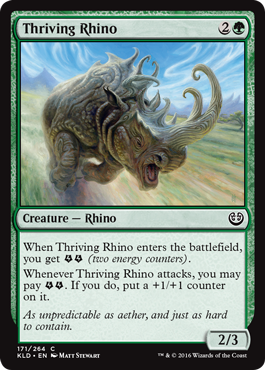
Thriving Rhino
2G
Creature — Rhino
2/3
When Thriving Rhino enters the battlefield, you get EE (two energy counters).
Whenever Thriving Rhino attacks, you may pay EE. If you do, put a +1/+1 counter on it.
- E is the energy symbol. It represents one energy counter.
- Energy counters are a kind of counter that a player may have. They’re not associated with specific permanents. (Other kinds of counters that players may have include poison and experience.)
- Keep careful track of how many energy counters each player has. You may do so by keeping a running count on paper, by using a die, or by any other clear and mutually agreeable method.
- If an effect says you get one or more E, you get that many energy counters. To pay one or more E, you lose that many energy counters. You can’t pay more energy counters than you have. Any effects that interact with counters a player gets, has, or loses can interact with energy counters.
- Energy counters aren’t mana. They don’t go away as steps, phases, and turns end, and effects that add mana “of any type” to your mana pool can’t give you energy counters.
- Some triggered abilities state that you “may pay” a certain amount of E. You can’t pay that amount multiple times to multiply the effect. You simply choose whether or not to pay that amount of E as the ability resolves, and no player may take actions to try to stop the ability’s effect after you make your choice.
- If a triggered ability with one or more targets states that you “may pay” some amount of E, and each permanent that it targets has become an illegal target, the ability is countered. You can’t pay any E even if you want to.
New Mechanic: Vehicles and Crew
Thanks to the ingenious inventors of Kaladesh, you can assemble artifacts that pack a lot of punch in combat—once you task a few creatures with getting them up and running.
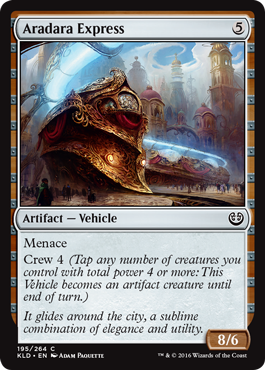
Aradara Express
5
Artifact — Vehicle
8/6
Menace
Crew 4 (Tap any number of creatures you control with total power 4 or more: This Vehicle becomes an artifact creature until end of turn.)
The official rules for Vehicles are as follows:
301.7. Some artifacts have the subtype “Vehicle.” Vehicles have the crew ability, which allows them to become artifact creatures. See rule 702.121, “Crew.”
301.7a Each Vehicle has a printed power and toughness, but it has these characteristics only if it’s also a creature. See rule 208.3.
301.7b If a Vehicle becomes a creature, it immediately has its printed power and toughness. Other effects, including the effect that makes it a creature, may modify these values or set them to different values.
The official rules for the crew keyword ability are as follows:
702.121. Crew
702.121a Crew is an activated ability of Vehicle cards. “Crew N” means “Tap any number of untapped creatures you control with total power N or greater: This permanent becomes an artifact creature until end of turn.”
702.121b A creature “crews a Vehicle” when it’s tapped to pay the cost to activate a Vehicle’s crew ability.
702.121c If an effect states that a creature “can’t crew Vehicles,” that creature can’t be tapped to pay the cost of a crew ability of a Vehicle.
- Each Vehicle is printed with a power and toughness, but a Vehicle is not a creature. If it becomes a creature (most likely through its crew ability, though the Kaladesh set includes other effects that could allow it to become a creature), it will have that power and toughness.
- If an effect causes a Vehicle to become an artifact creature with a specified power and toughness, that effect overwrites the Vehicle’s printed power and toughness.
- Any untapped creature you control can be tapped to pay a crew cost, even one that just came under your control.
- You may tap more creatures than necessary to activate a crew ability.
- Once a player announces that he or she is activating a crew ability, no player may take other actions until the ability has been paid for. Notably, players can’t try to stop the ability by changing a creature’s power or by removing or tapping a creature.
- Creatures that crew a Vehicle aren’t attached to it or related to it in any other way. Effects that affect the Vehicle, such as by destroying it or giving it a +1/+1 counter, don’t affect the creatures that crewed it.
- Once a Vehicle becomes a creature, it behaves exactly like any other artifact creature. It can’t attack unless you’ve controlled it continuously since your turn began, it can block if it’s untapped, it can be tapped to pay a Vehicle’s crew cost, and so on.
- Vehicle is an artifact type, not a creature type. A Vehicle that’s crewed won’t have any creature type.
- You may activate a crew ability of a Vehicle even if it’s already an artifact creature. Doing so has no effect on the Vehicle. It doesn’t change its power and toughness.
- For a Vehicle to be able to attack, it must be a creature as the declare attackers step begins, so the latest you can activate its crew ability to attack with it is during the beginning of combat step. For a Vehicle to be able to block, it must be a creature as the declare blockers step begins, so the latest you can activate its crew ability to block with it is during the declare attackers step. In either case, players may take actions after the crew ability resolves but before the Vehicle has been declared as an attacking or blocking creature.
- When a Vehicle becomes a creature, that doesn’t count as having a creature enter the battlefield. The permanent was already on the battlefield; it only changed its types. Abilities that trigger whenever a creature enters the battlefield won’t trigger.
- If a permanent becomes a copy of a Vehicle, the copy won’t be a creature, even if the Vehicle it’s copying has become an artifact creature.
New Rules Term: Create
“Create” is a new term for an old concept: the act of putting a token onto the battlefield.
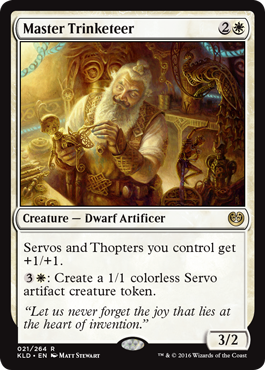
Master Trinketeer
2W
Creature — Dwarf Artificer
3/2
Servos and Thopters you control get +1/+1.
3W: Create a 1/1 colorless Servo artifact creature token.
- To create a token, put it onto the battlefield under your control.
- This new term doesn’t represent any functional change from tokens as you’ve known them. No rules for tokens or putting them onto the battlefield are changing other than the words used to present this game concept. The text of older cards that create tokens will be updated.
New Keyword Ability: Fabricate
Kaladesh is a world of inventors. Give them some parts, and they’ll create whatever tools they need for a given situation. The fabricate ability gives you the same flexibility.
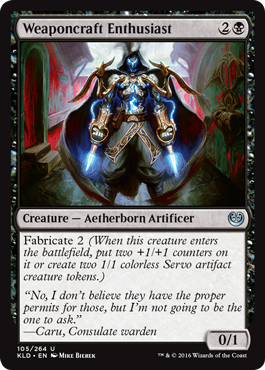
Weaponcraft Enthusiast
2B
Creature — Aetherborn Artificer
0/1
Fabricate 2 (When this creature enters the battlefield, put two +1/+1 counters on it or create two 1/1 colorless Servo artifact creature tokens.)
The official rules for fabricate are as follows:
702.122. Fabricate
702.122a Fabricate is a triggered ability. “Fabricate N” means “When this permanent enters the battlefield, you may put N +1/+1 counters on it. If you don’t, create N 1/1 colorless Servo artifact creature tokens.”
702.122b If a permanent has multiple instances of fabricate, each triggers separately.
- You choose whether to put +1/+1 counters on the creature or create Servo tokens as the fabricate ability is resolving. No player may take actions between the time you choose and the time that counters are added or tokens are created.
- Fabricate doesn’t cause the creature with the ability to enter the battlefield with +1/+1 counters already on it. For example, Weaponcraft Enthusiast will enter the battlefield as a 0/1 creature, then its fabricate ability goes on the stack. Players may take actions (such as casting instants) while the ability is waiting to resolve.
- If you can’t put +1/+1 counters on the creature for any reason (for instance, if it’s no longer on the battlefield), you just create Servo tokens.
Cycle: Gearhulks
The Gearhulks are five of the most awesome constructs the engineers of Kaladesh have put together. Each is an artifact creature that requires colored mana to cast and has a powerful triggered ability when it enters the battlefield.
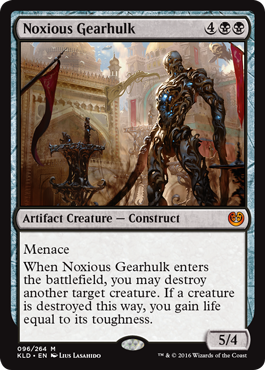
Noxious Gearhulk
4BB
Artifact Creature — Construct
5/4
Menace
When Noxious Gearhulk enters the battlefield, you may destroy another target creature. If a creature is destroyed this way, you gain life equal to its toughness.
- Each Gearhulk is an artifact creature that requires colored mana to cast. They aren’t colorless—each is the same color as the mana present in its mana cost.
Cycle: Kaladesh “Fast Lands”
The Kaladesh set includes a cycle of five lands that produce two colors of mana and enter the battlefield tapped unless you control two or fewer other lands.
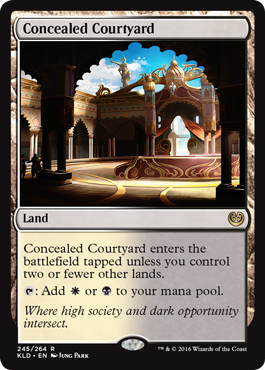
Concealed Courtyard
Land
Concealed Courtyard enters the battlefield tapped unless you control two or fewer other lands.
T: Add W or B to your mana pool.
- If one of these lands is your first, second, or third land, it enters the battlefield untapped. If you control three or more other lands, however, it enters the battlefield tapped.
- If one of these lands enters the battlefield at the same time as one or more other lands (due to Scapeshift or Warp World, perhaps), it doesn’t take those lands into consideration when determining how many other lands you control.
New Presentation: Story Spotlight Cards
There are many important moments in the Kaladesh story, but the five most crucial—called “story spotlights”—are shown on cards. You can read more about these events in the official Magic fiction at mtgstory.com.
Story spotlight 1: Inventors’ Fair
Story spotlight 2: Captured by the Consulate
Story spotlight 3: Deadlock Trap
Story spotlight 4: Fateful Showdown
Story spotlight 5: Confiscation Coup
The story spotlight cards in the Kaladesh set feature a Planeswalker symbol icon in their text boxes. The icon has no effect on game play. The printed cards also include the mtgstory.com URL and a number indicating the sequence of the cards in the story.
CARD-SPECIFIC NOTES
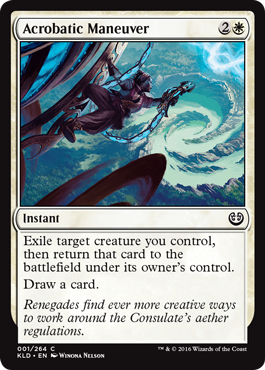
Acrobatic Maneuver
2W
Instant
Exile target creature you control, then return that card to the battlefield under its owner’s control.
Draw a card.
- After the creature returns to the battlefield, it will be a new object with no connection to the creature that was exiled. It won’t be in combat or have any additional abilities it may have had before it was exiled. Any +1/+1 counters on it or Auras attached to it are removed, and any Equipment will no longer be attached.
- If a creature token is exiled this way, it will cease to exist and won’t return to the battlefield.
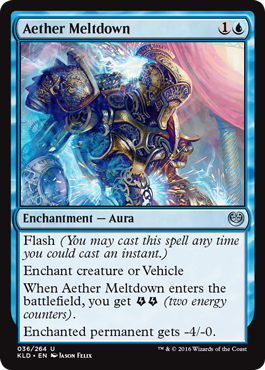
Aether Meltdown
1U
Enchantment — Aura
Flash (You may cast this spell any time you could cast an instant.)
Enchant creature or Vehicle
When Aether Meltdown enters the battlefield, you get EE (two energy counters).
Enchanted permanent gets -4/-0.
- If the target creature or Vehicle becomes an illegal target while Aether Meltdown is on the stack, Aether Meltdown will be countered. It won’t enter the battlefield and you won’t get EE.
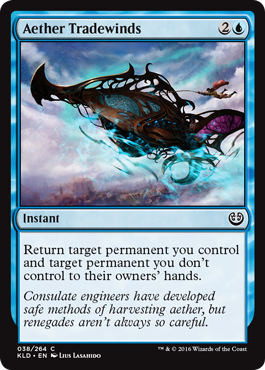
Aether Tradewinds
2U
Instant
Return target permanent you control and target permanent you don’t control to their owners’ hands.
- If one target permanent becomes an illegal target, the other will be returned to its owner’s hand. If both targets become illegal, Aether Tradewinds will be countered.
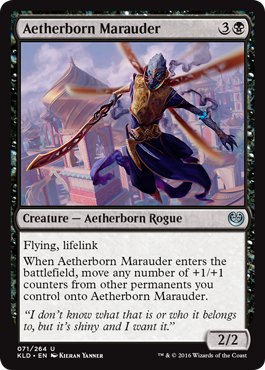
Aetherborn Marauder
3B
Creature — Aetherborn Rogue
2/2
Flying, lifelink
When Aetherborn Marauder enters the battlefield, move any number of +1/+1 counters from other permanents you control onto Aetherborn Marauder.
- You may move +1/+1 counters from any number of other permanents you control, not just from one.
- You choose which counters to move as Aetherborn Marauder’s triggered ability resolves.
- You may choose to move zero +1/+1 counters.
- If a creature has been dealt damage, that damage remains marked on it until the cleanup step. If Aetherborn Marauder takes counters from a creature that has been dealt damage, that creature will be destroyed if the damage is now lethal.

Aetherflux Reservoir
4
Artifact
Whenever you cast a spell, you gain 1 life for each spell you’ve cast this turn.
Pay 50 life: Aetherflux Reservoir deals 50 damage to target creature or player.
- The first ability counts the spell that caused it to trigger plus any other spells you cast earlier in the turn.
- The first ability counts spells you cast earlier in the turn even if you didn’t control Aetherflux Reservoir as you cast them, and even if those spells were countered.
- The number of spells you’ve cast is counted only as Aetherflux Reservoir’s triggered ability resolves. For example, if you cast a spell, then respond to the triggered ability with a second spell, you’ll gain 4 life total.
- Aetherflux Reservoir’s first ability doesn’t trigger when you cast Aetherflux Reservoir itself.
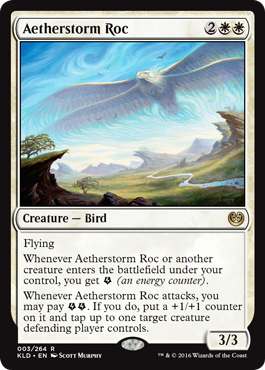
Aetherstorm Roc
2WW
Creature — Bird
3/3
Flying
Whenever Aetherstorm Roc or another creature enters the battlefield under your control, you get E (an energy counter).
Whenever Aetherstorm Roc attacks, you may pay EE. If you do, put a +1/+1 counter on it and tap up to one target creature defending player controls.
- A creature entering the battlefield at the same time as Aetherstorm Roc causes its first triggered ability to trigger.
- Aetherstorm Roc’s last triggered ability resolves before blockers are chosen. A creature tapped this way won’t be able to block.
- You don’t have to target a creature with Aetherstorm Roc’s last ability. If you do choose a target, and that target becomes illegal, the ability is countered and you won’t be able to pay EE to put a counter on Aetherstorm Roc.
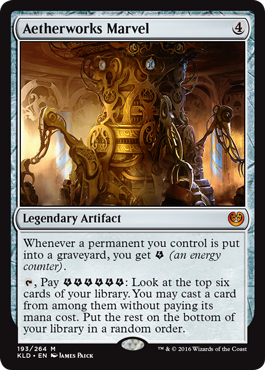
Aetherworks Marvel
4
Legendary Artifact
Whenever a permanent you control is put into a graveyard, you get E (an energy counter).
T, Pay EEEEEE: Look at the top six cards of your library. You may cast a card from among them without paying its mana cost. Put the rest on the bottom of your library in a random order.
- Aetherworks Marvel’s first ability triggers whenever any permanent you control is put into a graveyard from the battlefield, including Aetherworks Marvel itself and other permanents put into a graveyard at the same time as it.
- Tokens that are sacrificed or destroyed are put into their owner’s graveyard before ceasing to exist. If you controlled the token, Aetherworks Marvel’s first ability will trigger.
- The card cast with Aetherworks Marvel’s second ability is cast from your library.
- If you cast a card “without paying its mana cost,” you can’t pay any alternative costs, such as emerge costs. You can, however, pay additional costs. If the card has any mandatory additional costs, such as that of Incendiary Sabotage, you must pay those to cast the card.
- If the card has X in its mana cost, you must choose 0 as the value of X when casting it without paying its mana cost.
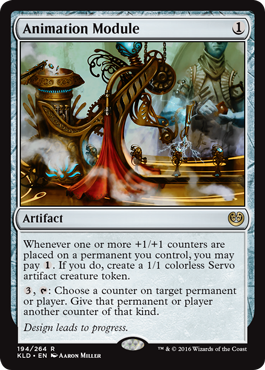
Animation Module
1
Artifact
Whenever one or more +1/+1 counters are placed on a permanent you control, you may pay 1. If you do, create a 1/1 colorless Servo artifact creature token.
3, T: Choose a counter on target permanent or player. Give that permanent or player another counter of that kind.
- If +1/+1 counters are placed on more than one permanent you control at the same time, Animation Module’s first ability triggers once for each of those permanents.
- Abilities that trigger when counters are placed on a permanent trigger when a permanent enters the battlefield with counters and when a player puts counters on a permanent.
- You can pay 1 only once each time Animation Module’s first ability resolves. You can’t pay more to create extra Servo tokens.
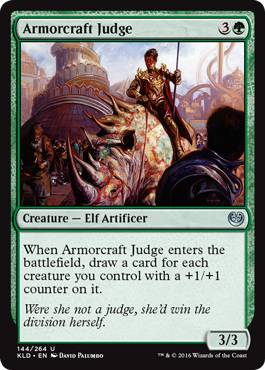
Armorcraft Judge
3G
Creature — Elf Artificer
3/3
When Armorcraft Judge enters the battlefield, draw a card for each creature you control with a +1/+1 counter on it.
- The number of creatures you control with +1/+1 counters on them is counted only as Armorcraft Judge’s triggered ability resolves. Players may respond to the triggered ability by trying to change that number.
- Armorcraft Judge’s ability counts the number of creatures, not the number of counters. A creature with more than one +1/+1 counter won’t cause you to draw more than one card.
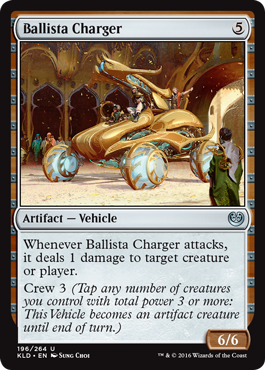
Ballista Charger
5
Artifact — Vehicle
6/6
Whenever Ballista Charger attacks, it deals 1 damage to target creature or player.
Crew 3 (Tap any number of creatures you control with total power 3 or more: This Vehicle becomes an artifact creature until end of turn.)
- Ballista Charger’s triggered ability resolves before blockers are chosen. A creature dealt lethal damage this way won’t be around to block.
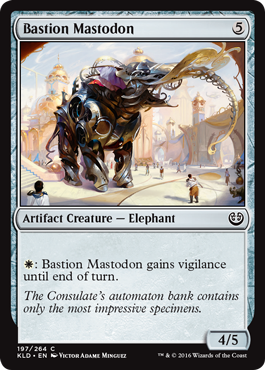
Bastion Mastodon
5
Artifact Creature — Elephant
4/5
W: Bastion Mastodon gains vigilance until end of turn.
- Once Bastion Mastodon is tapped and attacking, gaining vigilance won’t cause it to become untapped.
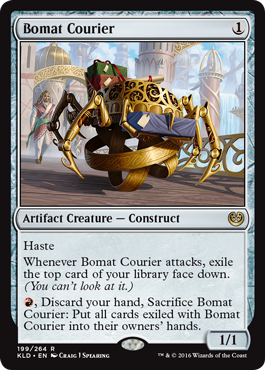
Bomat Courier
1
Artifact Creature — Construct
1/1
Haste
Whenever Bomat Courier attacks, exile the top card of your library face down. (You can’t look at it.)
R, Discard your hand, Sacrifice Bomat Courier: Put all cards exiled with Bomat Courier into their owners’ hands.
- Each Bomat Courier you control has its own cache of cards. Bomat Courier’s last ability only puts those cards into your hand, not those of any other Bomat Courier.
- If Bomat Courier leaves the battlefield before you activate its last ability, any cards exiled by its triggered ability remain exiled face down for the rest of the game. If you somehow return the same Bomat Courier card to the battlefield, it will be a different object with no connection to those face-down cards.
- You can pay the cost of “discard your hand” even if your hand contains zero cards.

Built to Last
W
Instant
Target creature gets +2/+2 until end of turn. If it’s an artifact creature, it gains indestructible until end of turn. (Damage and effects that say “destroy” don’t destroy it.)
- An artifact creature gains indestructible in addition to getting +2/+2, not instead of it.
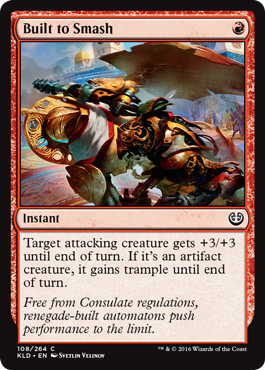
Built to Smash
R
Instant
Target attacking creature gets +3/+3 until end of turn. If it’s an artifact creature, it gains trample until end of turn.
- An artifact creature gains trample in addition to getting +3/+3, not instead of it.
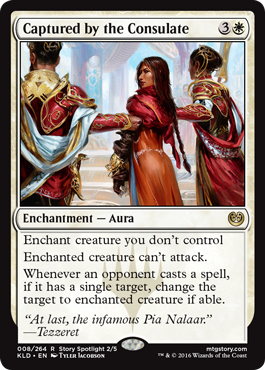
Captured by the Consulate
3W
Enchantment — Aura
Enchant creature you don’t control
Enchanted creature can’t attack.
Whenever an opponent casts a spell, if it has a single target, change the target to enchanted creature if able.
- When you attach Captured by the Consulate to an opponent’s creature, you still control Captured by the Consulate. Its last ability triggers whenever your opponents cast a spell with a single target, not when an opponent of the creature’s controller casts a spell with a single target.
- When a player casts an Aura spell, it targets the creature that it will enchant and may cause Captured by the Consulate’s last ability to trigger.
- If a spell has multiple targets, it doesn’t have a single target even if the same object is chosen for each of those targets.
- If the spell can’t target the enchanted creature, its target remains unchanged.
- If there is more than one Captured by the Consulate on the battlefield, the triggered ability of each one will change the target if able. The last one to resolve determines what that spell finally targets. If one player controls more than one Capture by the Consulate, he or she chooses the order in which they resolve. If multiple players control those Auras, the first player among them in turn order (starting with the player whose turn it is now) is the one whose triggered ability resolves last.
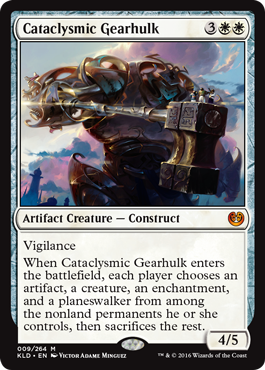
Cataclysmic Gearhulk
3WW
Artifact Creature — Construct
4/5
Vigilance
When Cataclysmic Gearhulk enters the battlefield, each player chooses an artifact, a creature, an enchantment, and a planeswalker from among the nonland permanents he or she controls, then sacrifices the rest.
- First the player whose turn it is chooses permanents he or she controls, then each other player in turn order does the same. Each player will know the choices made by players who chose before them. All of the unchosen nonland permanents are then sacrificed simultaneously.
- A permanent with more than one type may be chosen as either of the types or both. For example, an artifact creature may be chosen as the artifact, the creature, or both. Choosing the same permanent twice this way has the same result as choosing it once.
- Cataclysmic Gearhulk will be sacrificed to its own ability if you don’t choose it as your artifact or your creature.
- Lands can’t be chosen and won’t be sacrificed, even if they have other types (such as an artifact land).
- If you don’t control any permanents of one of the types, you’ll still choose the permanents of the types you do control.
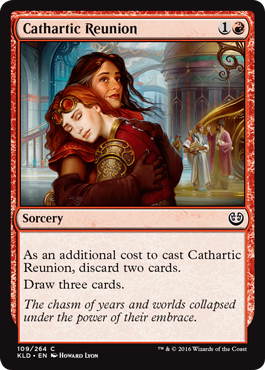
Cathartic Reunion
1R
Sorcery
As an additional cost to cast Cathartic Reunion, discard two cards.
Draw three cards.
- Because discarding two cards is an additional cost, you can’t cast Cathartic Reunion if you don’t have at least two other cards in hand.
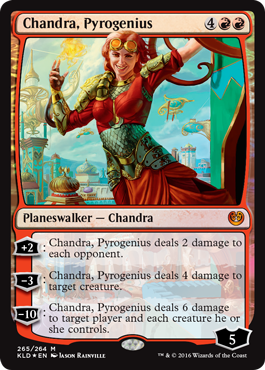
Chandra, Pyrogenius (Planeswalker Deck only)
4RR
Planeswalker — Chandra
5
+2: Chandra, Pyrogenius deals 2 damage to each opponent.
−3: Chandra, Pyrogenius deals 4 damage to target creature.
−10: Chandra, Pyrogenius deals 6 damage to target player and each creature he or she controls.
- The last ability of Chandra, Pyrogenius doesn’t target the creatures. A creature with hexproof the target player controls will be dealt damage this way.
- In a Two-Headed Giant game, Chandra’s first ability causes 4 damage total to be dealt to the opposing team.
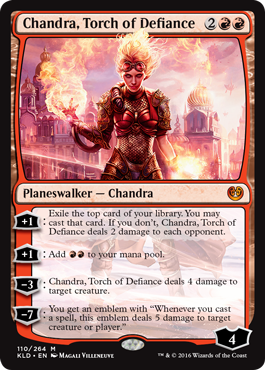
Chandra, Torch of Defiance
2RR
Planeswalker — Chandra
4
+1: Exile the top card of your library. You may cast that card. If you don’t, Chandra, Torch of Defiance deals 2 damage to each opponent.
+1: Add RR to your mana pool.
−3: Chandra, Torch of Defiance deals 4 damage to target creature.
−7: You get an emblem with “Whenever you cast a spell, this emblem deals 5 damage to target creature or player.”
- An effect that instructs you to “cast” a card doesn’t allow you to play lands. If the card exiled with Chandra’s first ability is a land card, you can’t play it and Chandra deals 2 damage to each opponent.
- If you cast the exiled card, you do so as part of the resolution of Chandra’s ability. You can’t wait to cast it later in the turn. Timing permissions based on the card’s type are ignored, but other restrictions (such as “Cast [this card] only during combat”) are not.
- You pay the costs for the exiled card if you cast it. You may pay alternative costs such as emerge rather than the card’s mana cost.
- Loyalty abilities can’t be mana abilities. Chandra’s second ability uses the stack and can be countered or otherwise responded to. Like all loyalty abilities, it can be activated only once per turn, during your main phase, when the stack is empty, and only if no other loyalty abilities of the planeswalker have been activated this turn.
- The emblem created by Chandra’s last ability is colorless. The damage it deals is from a colorless source.
- Chandra’s emblem’s ability resolves before the spell that caused it to trigger.
- In a Two-Headed Giant game, Chandra’s first ability causes 4 damage total to be dealt to the opposing team.
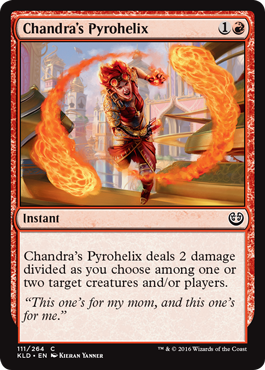
Chandra’s Pyrohelix
1R
Instant
Chandra’s Pyrohelix deals 2 damage divided as you choose among one or two target creatures and/or players.
- You divide the damage as you cast Chandra’s Pyrohelix, not as it resolves. Each target must be assigned at least 1 damage. In other words, as you cast Chandra’s Pyrohelix, you choose whether to have it deal 2 damage to a single target, or deal 1 damage to each of two targets.
- If Chandra’s Pyrohelix targets two creatures and one becomes an illegal target, the remaining target is dealt 1 damage, not 2.
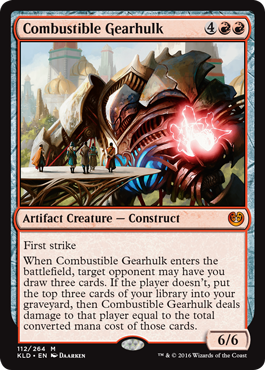
Combustible Gearhulk
4RR
Artifact Creature — Construct
6/6
First strike
When Combustible Gearhulk enters the battlefield, target opponent may have you draw three cards. If the player doesn’t, put the top three cards of your library into your graveyard, then Combustible Gearhulk deals damage to that player equal to the total converted mana cost of those cards.
- If any of the cards put into your graveyard have X in their mana cost, X is considered to be 0.
- If you have fewer than three cards in your library, the opponent may choose to have you draw three cards. If so, you’ll lose the game as state-based actions are performed.
- While Combustible Gearhulk’s triggered ability is resolving, no player may take any actions other than those specified by the Gearhulk. Once the opponent makes a choice, players can’t cast spells or activate abilities until after the cards are drawn or put into the graveyard and damage has been dealt (if applicable).
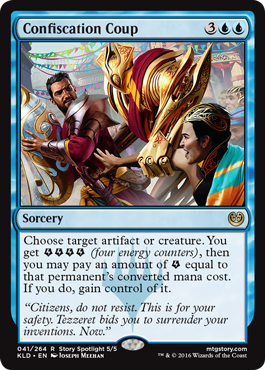
Confiscation Coup
3UU
Sorcery
Choose target artifact or creature. You get EEEE (four energy counters), then you may pay an amount of E equal to that permanent’s converted mana cost. If you do, gain control of it.
- You choose the target artifact or creature as you cast Confiscation Coup. You don’t choose whether or not to pay an amount of E until Confiscation Coup resolves. If the target becomes an illegal target, Confiscation Coup will be countered and you won’t get EEEE.
- If the target artifact or creature has a converted mana cost of 0, you may choose to pay zero energy and gain control of it.
- If a permanent has X in its mana cost, X is considered to be 0.
- The converted mana cost of a token that isn’t a copy of another object is 0. A token that is a copy of another object has the same mana cost as that object.
- In a multiplayer game, if a permanent’s owner leaves the game after you’ve gained control of it, the permanent leaves with that player. If you leave the game before that player, the control-change effect ends.
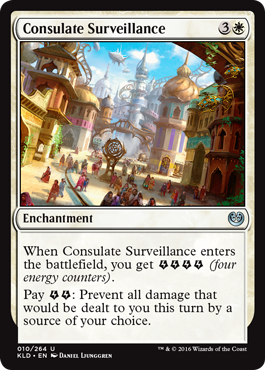
Consulate Surveillance
3W
Enchantment
When Consulate Surveillance enters the battlefield, you get EEEE (four energy counters).
Pay EE: Prevent all damage that would be dealt to you this turn by a source of your choice.
- Consulate Surveillance’s second ability doesn’t target anything. You choose a source of damage as it resolves.
- If the chosen source would deal damage to you and one or more other players or permanents, only the damage that would be dealt to you is prevented.
- If multiple prevention and/or replacement effects are trying to apply to the same damage, the player who would be dealt damage chooses the order in which to apply them. Notably, if noncombat damage would be dealt to you by a source controlled by an opponent, and you control a planeswalker, you choose the order in which to apply Consulate Surveillance’s effect and the planeswalker redirection effect. If you apply Consulate Surveillance’s effect first, the damage is prevented and the planeswalker redirection effect won’t apply.
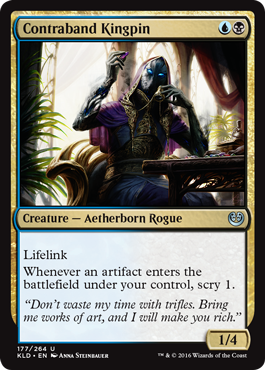
Contraband Kingpin
UB
Creature — Aetherborn Rogue
1/4
Lifelink
Whenever an artifact enters the battlefield under your control, scry 1.
- If multiple artifacts enter the battlefield simultaneously, you’ll scry 1 that many times. You won’t look at more than one card from your library at once.
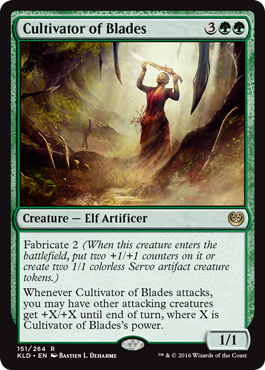
Cultivator of Blades
3GG
Creature — Elf Artificer
1/1
Fabricate 2 (When this creature enters the battlefield, put two +1/+1 counters on it or create two 1/1 colorless Servo artifact creature tokens.)
Whenever Cultivator of Blades attacks, you may have other attacking creatures get +X/+X until end of turn, where X is Cultivator of Blades’s power.
- The value of X is determined as Cultivator of Blades’s last ability resolves. It won’t change later, even if its power changes. If Cultivator of Blades is no longer on the battlefield, use its power as it last existed on the battlefield to determine the value of X.
- You choose whether or not to have your other attacking creatures get +X/+X as Cultivator of Blades’s triggered ability resolves, not as you put it onto the stack.
- If Cultivator of Blades’s power becomes negative, its last ability will lower power and toughness. For example, if Cultivator of Blades’s power is -2, its last ability gives -2/-2 (if you choose to give the creatures +X/+X).

Cultivator’s Caravan
3
Artifact — Vehicle
5/5
T: Add one mana of any color to your mana pool.
Crew 3 (Tap any number of creatures you control with total power 3 or more: This Vehicle becomes an artifact creature until end of turn.)
- As long as Cultivator’s Caravan isn’t an artifact creature, its T ability can be activated if it came under your control this turn.
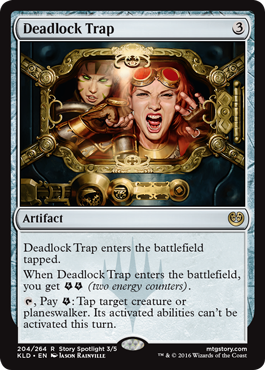
Deadlock Trap
3
Artifact
Deadlock Trap enters the battlefield tapped.
When Deadlock Trap enters the battlefield, you get EE (two energy counters).
T, Pay E: Tap target creature or planeswalker. Its activated abilities can’t be activated this turn.
- Activated abilities contain a colon. They’re generally written “[Cost]: [Effect].” Some keywords are activated abilities and will have colons in their reminder text.
- Once a player has announced an ability, Deadlock Trap can’t be used to prevent it. The last ability must be activated before that player activates that ability.
- Players may respond to Deadlock Trap’s last ability by activating an ability of the target permanent if that ability’s timing permissions allow it.
- After a planeswalker enters the battlefield, the active player receives priority and may activate an ability of that planeswalker before any player can activate Deadlock Trap’s last ability.
- A tapped planeswalker can be attacked or dealt damage as normal.
- If the tapped creature somehow becomes untapped, it can attack and block as normal, but its abilities still can’t be activated this turn.
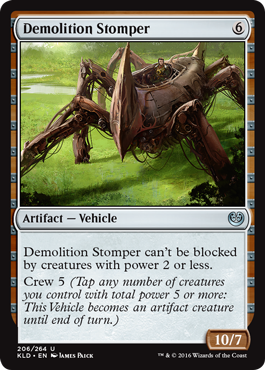
Demolition Stomper
6
Artifact — Vehicle
10/7
Demolition Stomper can’t be blocked by creatures with power 2 or less.
Crew 5 (Tap any number of creatures you control with total power 5 or more: This Vehicle becomes an artifact creature until end of turn.)
- Once a creature with power 3 or greater has blocked Demolition Stomper, changing the power of the blocking creature won’t cause Demolition Stomper to become unblocked.
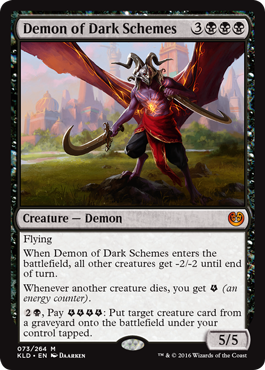
Demon of Dark Schemes
3BBB
Creature — Demon
5/5
Flying
When Demon of Dark Schemes enters the battlefield, all other creatures get -2/-2 until end of turn.
Whenever another creature dies, you get E (an energy counter).
2B, Pay EEEE: Put target creature card from a graveyard onto the battlefield under your control tapped.
- The set of creatures affected by Demon of Dark Schemes’s first triggered ability is determined as the ability resolves. Creatures that enter the battlefield later in the turn and noncreature permanents that become creatures later in the turn won’t get -2/-2.
- Demon of Dark Schemes’s second triggered ability triggers whenever another creature dies for any reason, not just due to the first triggered ability.
- If Demon of Dark Schemes dies at the same time as another creature, its second triggered ability triggers.
- If a creature’s owner leaves the game after you’ve put that creature onto the battlefield with Demon of Dark Schemes’s last ability, the creature leaves with that player. If you leave the game before that player, the creature is exiled.
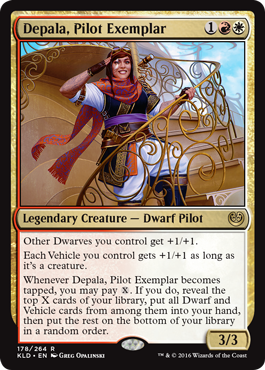
Depala, Pilot Exemplar
1RW
Legendary Creature — Dwarf Pilot
3/3
Other Dwarves you control get +1/+1.
Each Vehicle you control gets +1/+1 as long as it’s a creature.
Whenever Depala, Pilot Exemplar becomes tapped, you may pay X. If you do, reveal the top X cards of your library, put all Dwarf and Vehicle cards from among them into your hand, then put the rest on the bottom of your library in a random order.
- Depala, Pilot Exemplar’s last ability is a triggered ability, not an activated ability. It doesn’t allow you to tap Depala whenever you want; rather, you need some other way of tapping it, such as by attacking.
- For the ability to trigger, Depala has to actually change from untapped to tapped. If an effect attempts to tap Depala, but it was already tapped at the time, this ability won’t trigger.
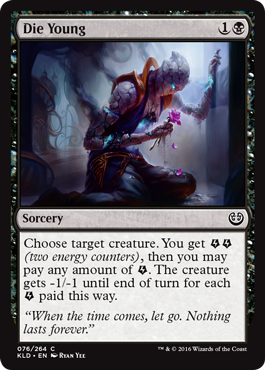
Die Young
1B
Sorcery
Choose target creature. You get EE (two energy counters), then you may pay any amount of E. The creature gets -1/-1 until end of turn for each E paid this way.
- You choose the target creature as you cast Die Young. You don’t choose how much E to pay until Die Young is resolving. No player may take actions between the time you choose how much E to pay and the time the creature gets -1/-1 for each E paid this way.
- If the target creature becomes an illegal target, Die Young is countered and none of its effects happen. You won’t get EE or be able to pay any E.
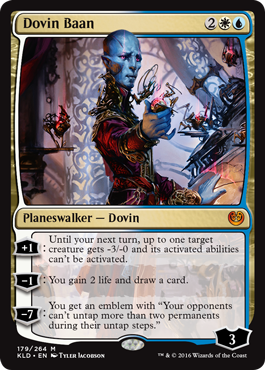
Dovin Baan
2WU
Planeswalker — Dovin
3
+1: Until your next turn, up to one target creature gets -3/-0 and its activated abilities can’t be activated.
−1: You gain 2 life and draw a card.
−7: You get an emblem with “Your opponents can’t untap more than two permanents during their untap steps.”
- Dovin Baan’s first ability can target any creature, not just one with an activated ability. It can also be activated targeting no creature at all.
- Activated abilities contain a colon. They’re generally written “[Cost]: [Effect].” Some keywords are activated abilities and will have colons in their reminder text.
- An opponent affected by Dovin Baan’s emblem chooses which two of his or her permanents to untap, not you.
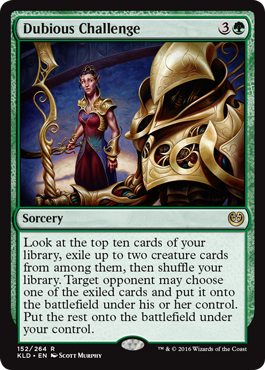
Dubious Challenge
3G
Sorcery
Look at the top ten cards of your library, exile up to two creature cards from among them, then shuffle your library. Target opponent may choose one of the exiled cards and put it onto the battlefield under his or her control. Put the rest onto the battlefield under your control.
- The creature cards you exile are face up. Your opponent can see them while deciding whether to take one and which to take.
- You may choose to exile only one creature card. If you do, the target opponent chooses who gets the card.
- You may choose to exile no creature cards, even if there are one or more among the top ten cards of your library.
- The cards that you look at but don’t exile never leave your library. They’re shuffled along with the rest of your library.
- In a multiplayer game, you must choose the target opponent before you look at your top ten cards and decide what to exile.
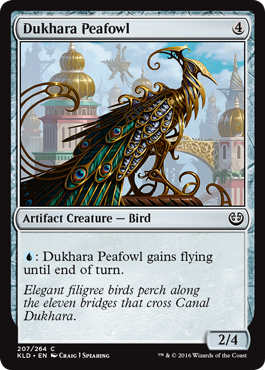
Dukhara Peafowl
4
Artifact Creature — Bird
2/4
U: Dukhara Peafowl gains flying until end of turn.
- Activating Dukhara Peafowl’s ability after it’s been blocked by a creature without flying or reach won’t cause it to become unblocked.
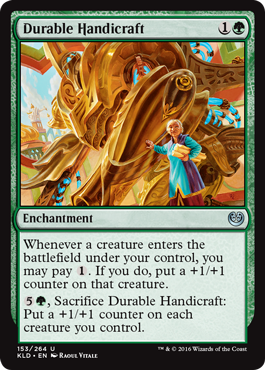
Durable Handicraft
1G
Enchantment
Whenever a creature enters the battlefield under your control, you may pay 1. If you do, put a +1/+1 counter on that creature.
5G, Sacrifice Durable Handicraft: Put a +1/+1 counter on each creature you control.
- You don’t choose whether to pay 1 until Durable Handicraft’s triggered ability is resolving. No player may take actions between the time you choose to pay and the time the creature gets a +1/+1 counter.
- You can pay 1 only once each time Durable Handicraft’s triggered ability resolves. You can’t pay more to put multiple +1/+1 counters on a creature.
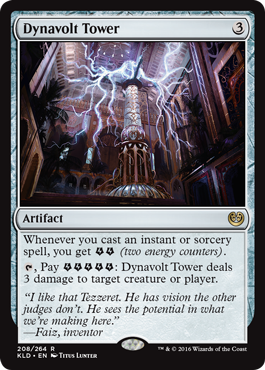
Dynavolt Tower
3
Artifact
Whenever you cast an instant or sorcery spell, you get EE (two energy counters).
T, Pay EEEEE: Dynavolt Tower deals 3 damage to target creature or player.
- Dynavolt Tower’s triggered ability resolves before the spell that caused it to trigger.
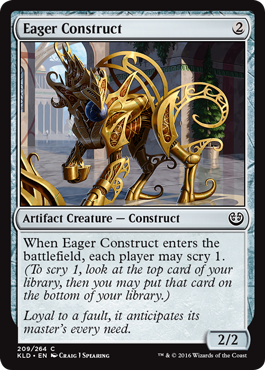
Eager Construct
2
Artifact Creature — Construct
2/2
When Eager Construct enters the battlefield, each player may scry 1. (To scry 1, look at the top card of your library, then you may put that card on the bottom of your library.)
- As Eager Construct’s triggered ability resolves, first the player whose turn it is scrys 1, then each other player in turn order does the same. Each player will know the choices made by players who chose before them.
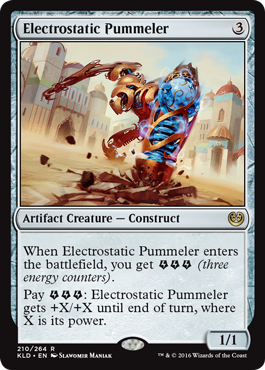
Electrostatic Pummeler
3
Artifact Creature — Construct
1/1
When Electrostatic Pummeler enters the battlefield, you get EEE (three energy counters).
Pay EEE: Electrostatic Pummeler gets +X/+X until end of turn, where X is its power.
- The value of X is determined as Electrostatic Pummeler’s last ability resolves.
- If Electrostatic Pummeler’s power becomes negative, its last ability will lower power and toughness. For example, if Electrostatic Pummeler’s power is -2, its last ability gives it -2/-2.

Elegant Edgecrafters
4GG
Creature — Elf Artificer
3/4
Elegant Edgecrafters can’t be blocked by creatures with power 2 or less.
Fabricate 2 (When this creature enters the battlefield, put two +1/+1 counters on it or create two 1/1 colorless Servo artifact creature tokens.)
- Once a creature with power 3 or greater has blocked Elegant Edgecrafters, changing the power of the blocking creature won’t cause Elegant Edgecrafters to become unblocked.
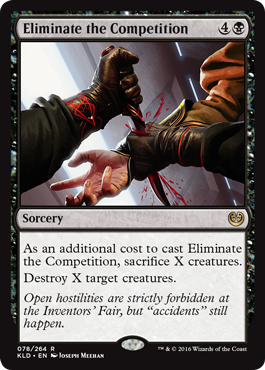
Eliminate the Competition
4B
Sorcery
As an additional cost to cast Eliminate the Competition, sacrifice X creatures.
Destroy X target creatures.
- Once you announce that you’re casting Eliminate the Competition, players can’t try to remove creatures you’d like to sacrifice.
- If you somehow cast Eliminate the Competition without paying its mana cost, you’ll still choose a value for X and sacrifice X creatures.
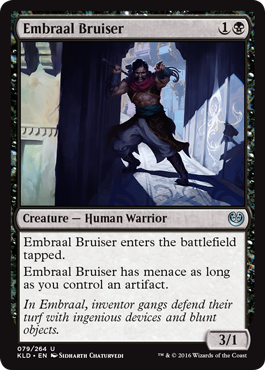
Embraal Bruiser
1B
Creature — Human Warrior
3/1
Embraal Bruiser enters the battlefield tapped.
Embraal Bruiser has menace as long as you control an artifact.
- Once a creature has blocked Embraal Bruiser, gaining menace won’t cause Embraal Bruiser to become unblocked.
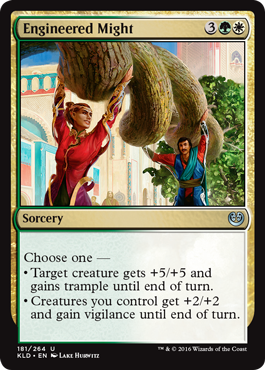
Engineered Might
3GW
Sorcery
Choose one —
• Target creature gets +5/+5 and gains trample until end of turn.
• Creatures you control get +2/+2 and gain vigilance until end of turn.
- The set of creatures affected by Engineered Might’s second mode is determined as the spell resolves. Creatures you begin to control later in the turn and noncreature permanents that become creatures later in the turn won’t get +2/+2 or gain vigilance.

Era of Innovation
1U
Enchantment
Whenever an artifact or Artificer enters the battlefield under your control, you may pay 1. If you do, you get EE (two energy counters).
Pay EEEEEE, Sacrifice Era of Innovation: Draw three cards.
- If a creature that is both an artifact and an Artificer enters the battlefield under your control, Era of Innovation’s triggered ability triggers only once.
- You can pay 1 only once each time Era of Innovation’s first ability resolves. You can’t pay more to get more than EE.
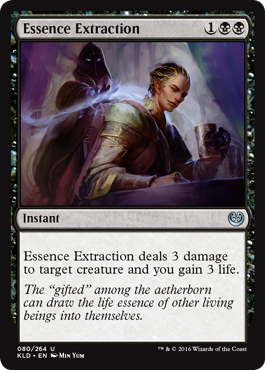
Essence Extraction
1BB
Instant
Essence Extraction deals 3 damage to target creature and you gain 3 life.
- If the target creature becomes an illegal target, Essence Extraction is countered and you don’t gain life.
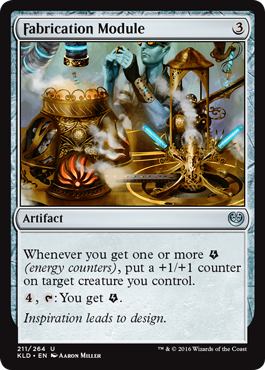
Fabrication Module
3
Artifact
Whenever you get one or more E (energy counters), put a +1/+1 counter on target creature you control.
4, T: You get E.
- If you get multiple E at once, you only put one +1/+1 counter on a creature, not one counter for each E. If you get multiple E at different times, Fabrication Module’s ability triggers once each time.
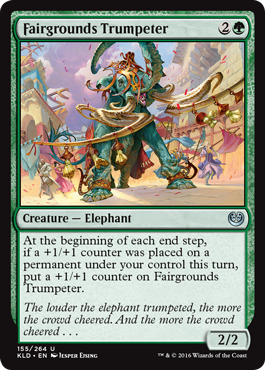
Fairgrounds Trumpeter
2G
Creature — Elephant
2/2
At the beginning of each end step, if a +1/+1 counter was placed on a permanent under your control this turn, put a +1/+1 counter on Fairgrounds Trumpeter.
- Fairgrounds Trumpeter’s ability triggers if, at any point during this turn, a +1/+1 counter was placed on a permanent that you controlled as the counter was placed. It doesn’t matter whether you still control the permanent or whether it still has a counter.
- If a +1/+1 counter hasn’t been placed yet at the moment an end step begins, Fairgrounds Trumpeter’s ability doesn’t trigger at all. If another ability triggers during the end step and puts a +1/+1 counter on a permanent you control, you won’t put a +1/+1 counter on Fairgrounds Trumpeter.
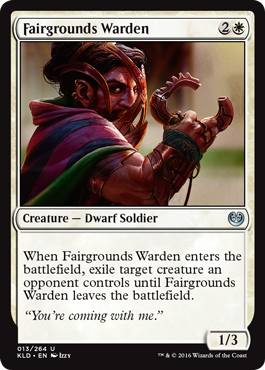
Fairgrounds Warden
2W
Creature — Dwarf Soldier
1/3
When Fairgrounds Warden enters the battlefield, exile target creature an opponent controls until Fairgrounds Warden leaves the battlefield.
- If Fairgrounds Warden leaves the battlefield before its triggered ability resolves, the target creature won’t be exiled.
- Auras attached to the exiled creature will be put into their owners’ graveyards. Any Equipment will become unattached and remain on the battlefield. Any counters on the exiled permanent will cease to exist.
- If a creature token is exiled this way, it will cease to exist and won’t return to the battlefield.
- The exiled card returns to the battlefield immediately after Fairgrounds Warden leaves the battlefield. Nothing happens between the two events, including state-based actions.
- In a multiplayer game, if Fairgrounds Warden’s owner leaves the game, the exiled card will return to the battlefield. Because the one-shot effect that returns the card isn’t an ability that goes on the stack, it won’t cease to exist along with the leaving player’s spells and abilities on the stack.

Fateful Showdown
2RR
Instant
Fateful Showdown deals damage to target creature or player equal to the number of cards in your hand. Discard all the cards in your hand, then draw that many cards.
- The number of cards in your hand is counted only as Fateful Showdown resolves. Fateful Showdown is on the stack at this time, so it’s not counted.
- If Fateful Showdown’s target becomes an illegal target, you won’t discard your hand or draw any cards.
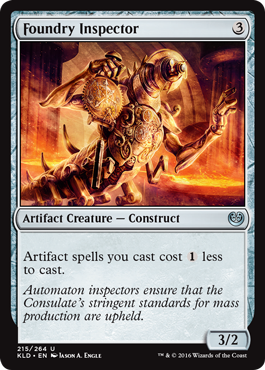
Foundry Inspector
3
Artifact Creature — Construct
3/2
Artifact spells you cast cost 1 less to cast.
- If an artifact spell has X in its mana cost, choose the value for X first, and then reduce the cost by 1. For example, an artifact that costs X with X chosen as 4 costs 3 to cast if you control Foundry Inspector.
- Once a player has announced an artifact spell, no player may take actions to try to remove Foundry Inspector from the battlefield before that spell’s cost is locked in.
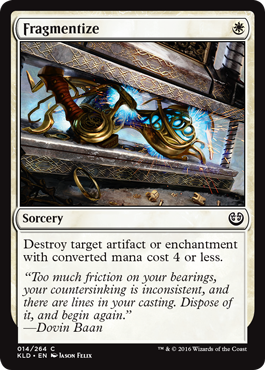
Fragmentize
W
Sorcery
Destroy target artifact or enchantment with converted mana cost 4 or less.
- If a permanent has X in its mana cost, X is considered to be 0.
- The converted mana cost of a token that isn’t a copy of another object is 0. A token that is a copy of another object has the same mana cost as that object.
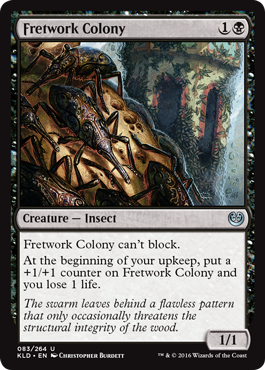
Fretwork Colony
1B
Creature — Insect
1/1
Fretwork Colony can’t block.
At the beginning of your upkeep, put a +1/+1 counter on Fretwork Colony and you lose 1 life.
- You lose 1 life even if you can’t put a +1/+1 counter on Fretwork Colony, perhaps because it left the battlefield in response to its triggered ability.
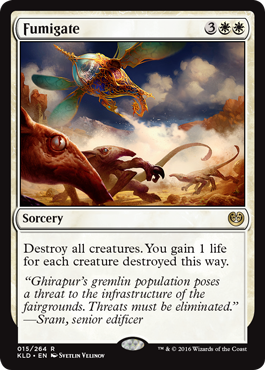
Fumigate
3WW
Sorcery
Destroy all creatures. You gain 1 life for each creature destroyed this way.
- Creatures destroyed this way count toward the life gained even if they’re put into a zone other than a graveyard.
- Creatures with indestructible aren’t destroyed this way.
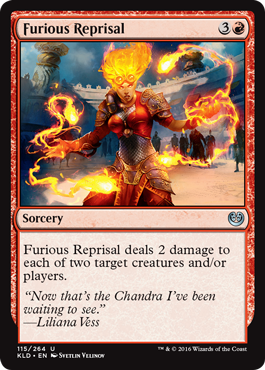
Furious Reprisal
3R
Sorcery
Furious Reprisal deals 2 damage to each of two target creatures and/or players.
- You can’t target the same creature or player twice to have one recipient be dealt 4 damage.
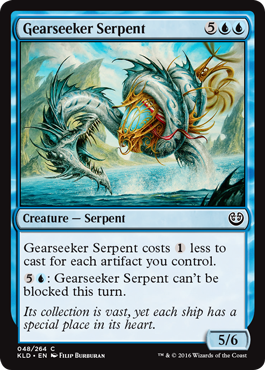
Gearseeker Serpent
5UU
Creature — Serpent
5/6
Gearseeker Serpent costs 1 less to cast for each artifact you control.
5U: Gearseeker Serpent can’t be blocked this turn.
- The total cost to cast Gearseeker Serpent is locked in before you pay that cost. For example, if you control three artifacts, including one you can sacrifice to add {C} to your mana pool, the total cost of Gearseeker Serpent is 2UU. Then you can sacrifice the artifact when you activate mana abilities just before paying the cost.
- Once a player has announced that he or she is casting Gearseeker Serpent, no player may take actions to try to change the number of artifacts its controller controls before the spell’s cost is locked in.
- Gearseeker Serpent’s first ability can’t reduce the total cost to cast the spell below UU.
- Once Gearseeker Serpent has been blocked, activating its last ability won’t cause it to become unblocked.
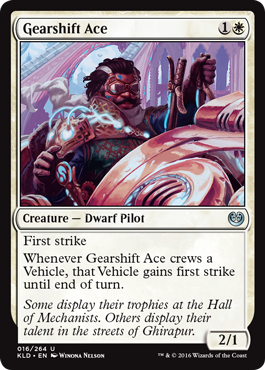
Gearshift Ace
1W
Creature — Dwarf Pilot
2/1
First strike
Whenever Gearshift Ace crews a Vehicle, that Vehicle gains first strike until end of turn.
- Gearshift Ace’s triggered ability triggers when it becomes tapped to activate a crew ability. Even if Gearshift Ace leaves the battlefield before its triggered ability resolves, that Vehicle still gains first strike until end of turn.
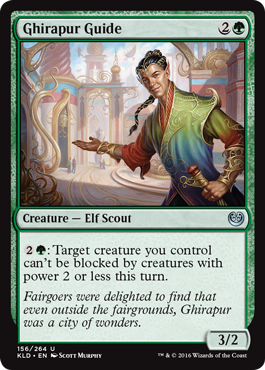
Ghirapur Guide
2G
Creature — Elf Scout
3/2
2G: Target creature you control can’t be blocked by creatures with power 2 or less this turn.
- Once an attacking creature has been blocked, activating Ghirapur Guide’s ability won’t cause it to become unblocked. If a creature with power 3 or greater has blocked a creature affected by Ghirapur Guide’s ability, changing the power of the blocking creature won’t cause the attacking creature to become unblocked.
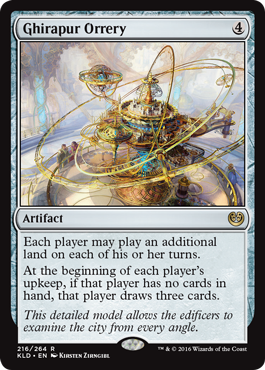
Ghirapur Orrery
4
Artifact
Each player may play an additional land on each of his or her turns.
At the beginning of each player’s upkeep, if that player has no cards in hand, that player draws three cards.
- Ghirapur Orrery’s first ability allows a player to play an additional land during his or her main phase. Doing so follows the normal timing rules for playing lands.
- Ghirapur Orrery’s first ability is cumulative if more than one is on the battlefield.
- No player may take actions in a turn before Ghirapur Orrery’s second ability checks to see if it should trigger. If the player whose turn it is has any cards in hand, it won’t trigger.
- If the player has any cards in hand as Ghirapur Orrery’s second ability resolves, the ability does nothing. Notably, a second Ghirapur Orrery won’t have a player draw another three cards unless the player empties his or her hand after resolving the first one’s trigger.
- The draw step is after the upkeep step, so drawing a card as a turn-based action won’t affect whether Ghirapur Orrery’s second ability triggers.
- In a Two-Headed Giant game, Ghirapur Orrery’s second ability triggers for each player on a team separately. If one player has cards in hand, it can still trigger for the other player.
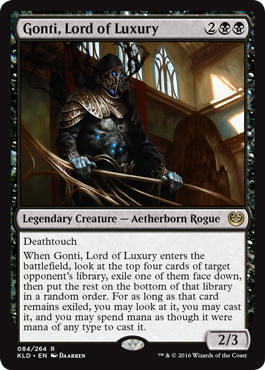
Gonti, Lord of Luxury
2BB
Legendary Creature — Aetherborn Rogue
2/3
Deathtouch
When Gonti, Lord of Luxury enters the battlefield, look at the top four cards of target opponent’s library, exile one of them face down, then put the rest on the bottom of that library in a random order. For as long as that card remains exiled, you may look at it, you may cast it, and you may spend mana as though it were mana of any type to cast it.
- You may look at and cast that card (and spend mana as though it were mana of any type to do so) even if Gonti leaves the battlefield. If another player gains control of Gonti, that player can’t look at or cast the card, and you still can.
- An effect that instructs you to “cast” a card doesn’t allow you to play lands.
- You pay the costs for the exiled card if you cast it. You may pay alternative costs such as emerge rather than the card’s mana cost.
- Gonti doesn’t change when you can cast the exiled card. For example, if you exile a creature card without flash, you can cast it only during your main phase when the stack is empty.
- Casting the card causes it to leave exile. You can’t cast it multiple times.
- If you leave the game, the card remains exiled face down indefinitely. No player may look at it.
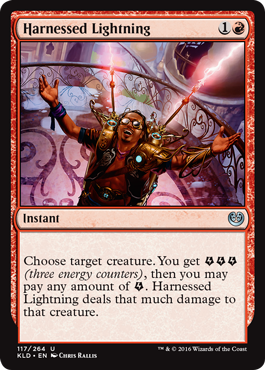
Harnessed Lightning
1R
Instant
Choose target creature. You get EEE (three energy counters), then you may pay any amount of E. Harnessed Lightning deals that much damage to that creature.
- You choose the target creature as you cast Harnessed Lightning. You don’t choose how much E to pay until Harnessed Lightning is resolving. No player may take actions between the time you choose how much E to pay and the time the creature takes damage equal to the E paid this way.
- If the target creature becomes an illegal target, Harnessed Lightning is countered and none of its effects happen. You won’t get EEE or be able to pay any E.
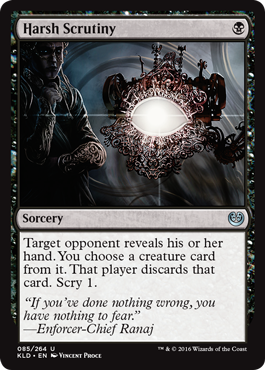
Harsh Scrutiny
B
Sorcery
Target opponent reveals his or her hand. You choose a creature card from it. That player discards that card. Scry 1.
- You scry 1 even if that player has no creature card to discard.
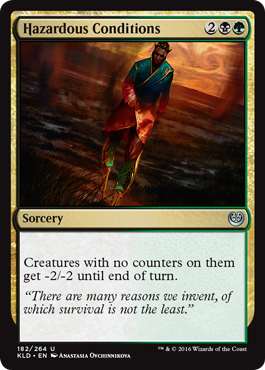
Hazardous Conditions
2BG
Sorcery
Creatures with no counters on them get -2/-2 until end of turn.
- Hazardous Conditions doesn’t care what kind of counter a creature has on it. Whether +1/+1, -1/-1, charge, or fate, any kind of counter causes a creature to be unaffected.
- The set of creatures affected by Hazardous Conditions is determined as the spell resolves. Creatures that get a counter later in the turn will continue to get -2/-2. Creatures that enter the battlefield or lose their counters later in the turn and noncreature permanents that become creatures later in the turn won’t get -2/-2.
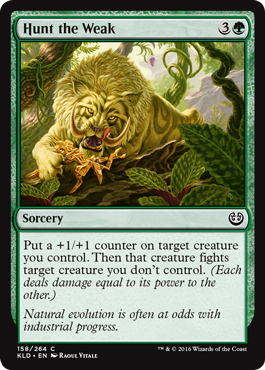
Hunt the Weak
3G
Sorcery
Put a +1/+1 counter on target creature you control. Then that creature fights target creature you don’t control. (Each deals damage equal to its power to the other.)
- You can’t cast Hunt the Weak unless you choose both a creature you control and a creature you don’t control as targets.
- If either target is an illegal target as Hunt the Weak resolves, neither creature will deal or be dealt damage.
- If the creature you control is an illegal target as Hunt the Weak tries to resolve, you won’t put a +1/+1 counter on it. If that creature is a legal target but the other creature isn’t, you’ll still put the counter on the creature you control.
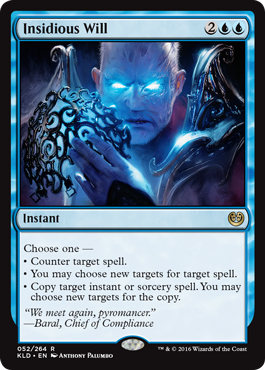
Insidious Will
2UU
Instant
Choose one —
• Counter target spell.
• You may choose new targets for target spell.
• Copy target instant or sorcery spell. You may choose new targets for the copy.
- If you choose new targets for the target spell or for the copy, the new targets must be legal.
- If you copy a spell, you control the copy.
- The third mode can copy any instant or sorcery spell, not just one with targets.
- The copy is created on the stack, so it’s not “cast.” Abilities that trigger when a player casts a spell won’t trigger.
- The copy will have the same targets as the spell it’s copying unless you choose new ones. You may change any number of the targets, including all of them or none of them. If, for one of the targets, you can’t choose a new legal target, then it remains unchanged (even if the current target is illegal).
- If the spell that’s copied is modal (that is, it says “Choose one —” or the like), the copy will have the same mode. A different mode cannot be chosen.
- If the spell that’s copied has an X whose value was determined as it was cast (like Eliminate the Competition does), the copy will have the same value of X.
- If the spell has damage divided as it was cast (like Chandra’s Pyrohelix), the division can’t be changed (although the targets receiving that damage still can).
- The controller of a copy can’t choose to pay any alternative or additional costs for the copy. However, effects based on any alternative or additional costs that were paid for the original spell are copied as though those same costs were paid for the copy.
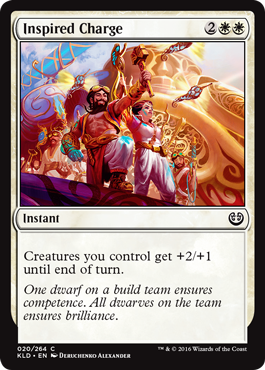
Inspired Charge
2WW
Instant
Creatures you control get +2/+1 until end of turn.
- The set of creatures affected by Inspired Charge is determined as the spell resolves. Creatures you begin to control later in the turn and noncreature permanents that become creatures later in the turn won’t get +2/+1.
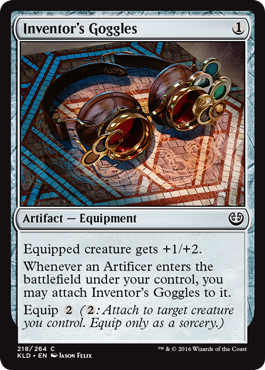
Inventor’s Goggles
1
Artifact — Equipment
Equipped creature gets +1/+2.
Whenever an Artificer enters the battlefield under your control, you may attach Inventor’s Goggles to it.
Equip 2 (2: Attach to target creature you control. Equip only as a sorcery.)
- If the Artificer that entered the battlefield leaves the battlefield before Inventor’s Goggles becomes attached, Inventor’s Goggles stays as it was. If it’s already attached to another creature, it remains attached to that creature.
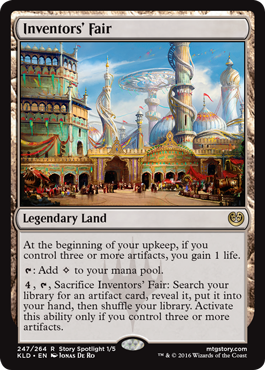
Inventors’ Fair
Legendary Land
At the beginning of your upkeep, if you control three or more artifacts, you gain 1 life.
T: Add {C} to your mana pool.
4, T, Sacrifice Inventors’ Fair: Search your library for an artifact card, reveal it, put it into your hand, then shuffle your library. Activate this ability only if you control three or more artifacts.
- No player may take actions in a turn before Inventors’ Fair’s triggered ability checks to see if it should trigger. If you don’t control three or more artifacts, it won’t trigger.
- If you control three artifacts as the ability resolves, you gain 1 life. The artifacts you control as the ability resolves don’t have to be the same ones you controlled as it triggered. If you don’t control three artifacts at that time, you won’t gain life.
- When using Inventors’ Fair’s last activated ability, the number of artifacts you control is checked only as you activate it. It’s not checked again as the ability resolves.
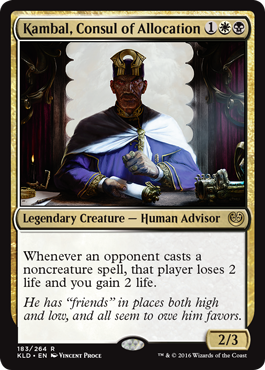
Kambal, Consul of Allocation
1WB
Legendary Creature — Human Advisor
2/3
Whenever an opponent casts a noncreature spell, that player loses 2 life and you gain 2 life.
- Kambal’s ability resolves before the spell that caused it to trigger.
- A noncreature spell is a spell that isn’t a creature at all. An artifact creature spell isn’t a noncreature spell. Lands are never spells.
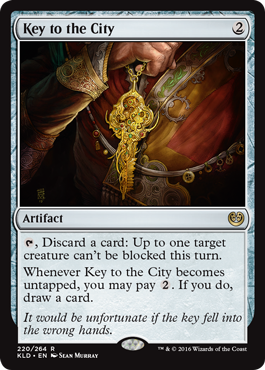
Key to the City
2
Artifact
T, Discard a card: Up to one target creature can’t be blocked this turn.
Whenever Key to the City becomes untapped, you may pay 2. If you do, draw a card.
- You can activate Key to the City’s first ability without targeting any creature.
- Activating Key to the City’s ability targeting a creature that has already been blocked won’t cause it to become unblocked.
- Key to the City’s last ability triggers during your untap step, but it’s put onto the stack at the same time as abilities that trigger at the beginning of your upkeep step. Even though Key to the City’s ability triggered first, you may order it before or after other abilities you control that are put onto the stack at this time.
- You can pay 2 only once each time Key to the City’s triggered ability resolves. You can’t pay more to draw additional cards.
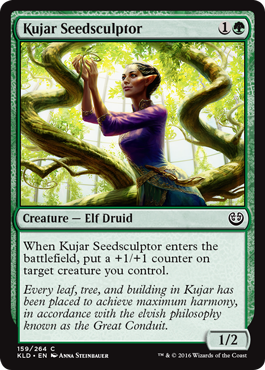
Kujar Seedsculptor
1G
Creature — Elf Druid
1/2
When Kujar Seedsculptor enters the battlefield, put a +1/+1 counter on target creature you control.
- Kujar Seedsculptor can be the target of its own triggered ability.
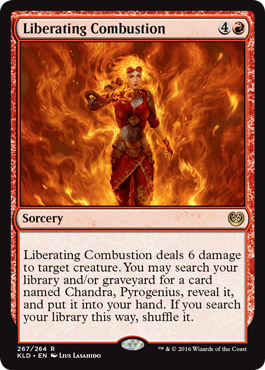
Liberating Combustion (Planeswalker Deck only)
4R
Sorcery
Liberating Combustion deals 6 damage to target creature. You may search your library and/or graveyard for a card named Chandra, Pyrogenius, reveal it, and put it into your hand. If you search your library this way, shuffle it.
- If the target creature becomes an illegal target for Liberating Combustion, the spell will be countered and none of its effects will happen. You won’t search for Chandra, Pyrogenius.
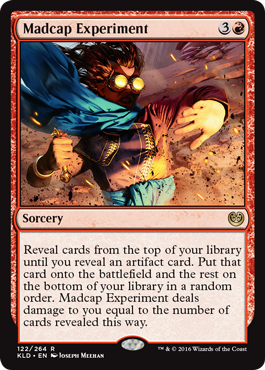
Madcap Experiment
3R
Sorcery
Reveal cards from the top of your library until you reveal an artifact card. Put that card onto the battlefield and the rest on the bottom of your library in a random order. Madcap Experiment deals damage to you equal to the number of cards revealed this way.
- The number of cards revealed this way includes the artifact card you put onto the battlefield.
- Once Madcap Experiment begins resolving, no player may take any actions other than those specified by Madcap Experiment until it’s done resolving.
- Any abilities that trigger as the artifact enters the battlefield aren’t put onto the stack until Madcap Experiment is done resolving.
- If you don’t reveal an artifact card, you’ll randomize your library and be dealt damage equal to the number of cards in your library.
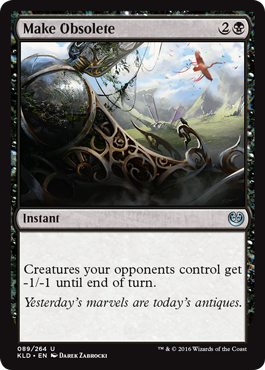
Make Obsolete
2B
Instant
Creatures your opponents control get -1/-1 until end of turn.
- The set of creatures affected by Make Obsolete is determined as the spell resolves. Creatures your opponents begin to control later in the turn and noncreature permanents that become creatures later in the turn won’t get -1/-1.
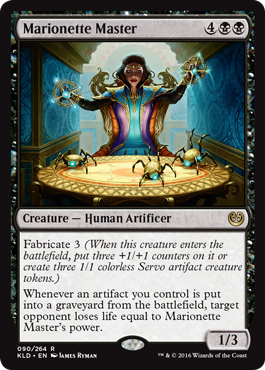
Marionette Master
4BB
Creature — Human Artificer
1/3
Fabricate 3 (When this creature enters the battlefield, put three +1/+1 counters on it or create three 1/1 colorless Servo artifact creature tokens.)
Whenever an artifact you control is put into a graveyard from the battlefield, target opponent loses life equal to Marionette Master’s power.
- The amount of life lost is determined as Marionette Master’s last ability resolves. If Marionette Master is no longer on the battlefield, use its power as it last existed on the battlefield to determine how much life is lost.
- If Marionette Master’s power is negative, the target opponent doesn’t lose (or gain) life.
- If Marionette Master and an artifact you control are put into a graveyard at the same time, Marionette Master’s ability triggers.
- Artifact tokens that are sacrificed or destroyed are put into their owner’s graveyard before ceasing to exist. If you controlled the token, Marionette Master’s last ability will trigger.

Master Trinketeer
2W
Creature — Dwarf Artificer
3/2
Servos and Thopters you control get +1/+1.
3W: Create a 1/1 colorless Servo artifact creature token.
- A creature that is both a Servo and a Thopter gets +1/+1, not +2/+2.
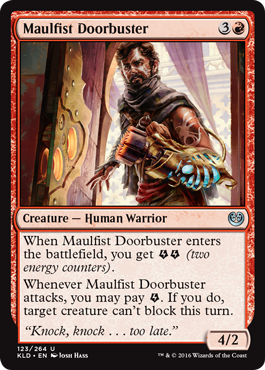
Maulfist Doorbuster
3R
Creature — Human Warrior
4/2
When Maulfist Doorbuster enters the battlefield, you get EE (two energy counters).
Whenever Maulfist Doorbuster attacks, you may pay E. If you do, target creature can’t block this turn.
- The target creature can’t block any creatures this turn. The effect isn’t restricted to just whether the creature can block Maulfist Doorbuster.
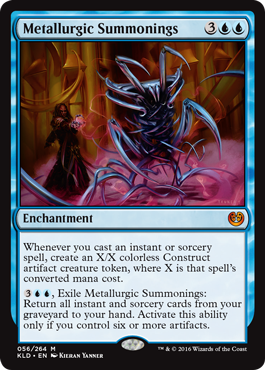
Metallurgic Summonings
3UU
Enchantment
Whenever you cast an instant or sorcery spell, create an X/X colorless Construct artifact creature token, where X is that spell’s converted mana cost.
3UU, Exile Metallurgic Summonings: Return all instant and sorcery cards from your graveyard to your hand. Activate this ability only if you control six or more artifacts.
- For a spell with X in its mana cost, use the value chosen for X to determine its converted mana cost. For example, Clash of Wills is an instant spell with mana cost XU. If you chose 2 as the value of X, then Clash of Wills has converted mana cost 3, and Metallurgic Summonings’s ability will create a 3/3 token.
- Metallurgic Summonings’s first ability resolves before the spell that caused it to trigger.
- If Metallurgic Summonings’s first ability resolves and the spell that caused it to trigger has been countered, use that spell’s converted mana cost as it last existed on the stack to determine the value of X.
- The number of artifacts you control is checked only as you activate Metallurgic Summonings’s last ability. It’s not checked again as it resolves.
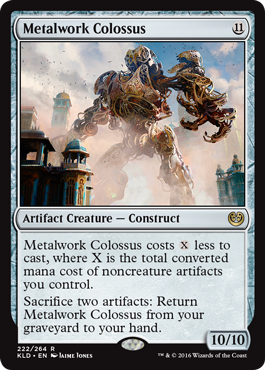
Metalwork Colossus
11
Artifact Creature — Construct
10/10
Metalwork Colossus costs X less to cast, where X is the total converted mana cost of noncreature artifacts you control.
Sacrifice two artifacts: Return Metalwork Colossus from your graveyard to your hand.
- If a permanent has X in its mana cost, X is considered to be 0.
- The total cost to cast Metalwork Colossus is locked in before you pay that cost. For example, if you control three noncreature artifacts each with converted mana cost 2, including one you can sacrifice to add {C} to your mana pool, the total cost of Metalwork Colossus is 5. Then you can sacrifice the artifact when you activate mana abilities just before paying the cost.
- If the total converted mana cost of noncreature artifacts you control is 11 or greater, Metalwork Colossus costs {0} to cast.
- Once a player has announced that he or she is casting Metalwork Colossus, no player may take actions to try to change the number of artifacts its controller controls before that spell’s cost is locked in.
- Metalwork Colossus’s last ability can be activated only if it is in your graveyard.
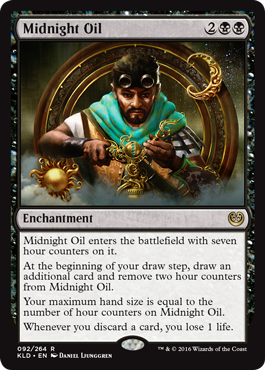
Midnight Oil
2BB
Enchantment
Midnight Oil enters the battlefield with seven hour counters on it.
At the beginning of your draw step, draw an additional card and remove two hour counters from Midnight Oil.
Your maximum hand size is equal to the number of hour counters on Midnight Oil.
Whenever you discard a card, you lose 1 life.
- If multiple effects try to set your maximum hand size to a certain number or state that you have no maximum hand size, the one created latest is the one that applies.
- If Midnight Oil has only one hour counter on it, its first triggered ability will remove that one counter.
- If Midnight Oil has no hour counters on it, its first triggered ability will continue to trigger and have you draw an additional card, even though you can’t remove any counters from it.
- Your maximum hand size is only checked during the cleanup step of your turn. At other times, you may have more cards in hand than your maximum hand size.
- If you discard a card during your cleanup step while you control Midnight Oil, its last ability will trigger, and players will get priority in your cleanup step. You’ll have another cleanup step after that one before continuing to the next player’s turn.
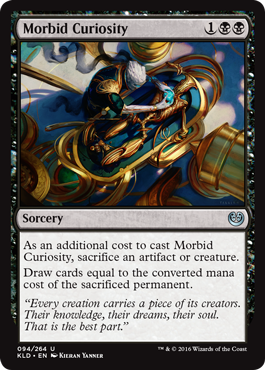
Morbid Curiosity
1BB
Sorcery
As an additional cost to cast Morbid Curiosity, sacrifice an artifact or creature.
Draw cards equal to the converted mana cost of the sacrificed permanent.
- If a permanent has X in its mana cost, X is considered to be 0.
- To determine how many cards to draw, use the converted mana cost of the permanent immediately before you sacrificed it.
- If an effect copies Morbid Curiosity, the controller of the copy will draw the same number of cards as determined by the original. Its controller can’t and doesn’t have to sacrifice a permanent.
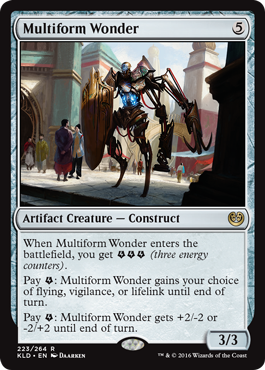
Multiform Wonder
5
Artifact Creature — Construct
3/3
When Multiform Wonder enters the battlefield, you get EEE (three energy counters).
Pay E: Multiform Wonder gains your choice of flying, vigilance, or lifelink until end of turn.
Pay E: Multiform Wonder gets +2/-2 or -2/+2 until end of turn.
- As you activate one of Multiform Wonder’s two activated abilities, you must announce which one you’re activating. However, you don’t choose that ability’s effect until it resolves. For example, you must announce that you’re activating Multiform Wonder’s middle ability specifically, but you don’t choose which of the keywords it gains until the ability resolves.
- Multiple instances of flying, vigilance, or lifelink are redundant.
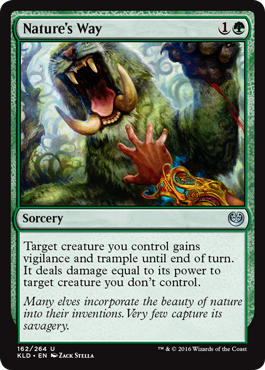
Nature’s Way
1G
Sorcery
Target creature you control gains vigilance and trample until end of turn. It deals damage equal to its power to target creature you don’t control.
- You can’t cast Nature’s Way unless you choose both a creature you control and a creature you don’t control as targets.
- If either target is an illegal target as Nature’s Way resolves, no damage will be dealt.
- If the creature you don’t control is an illegal target as Nature’s Way tries to resolve, the creature you control will still gain vigilance and trample.
- Trample only applies to the assignment of combat damage, not the damage Nature’s Way has the creature deal.

Night Market Lookout
B
Creature — Human Rogue
1/1
Whenever Night Market Lookout becomes tapped, each opponent loses 1 life and you gain 1 life.
- This is a triggered ability, not an activated ability. It doesn’t allow you to tap Night Market Lookout whenever you want; rather, you need some other way of tapping it, such as by attacking.
- For the ability to trigger, Night Market Lookout has to actually change from untapped to tapped. If an effect attempts to tap it, but it was already tapped at the time, this ability won’t trigger.
- In a Two-Headed Giant game, Night Market Lookout’s ability causes the opposing team to lose a total of 2 life.
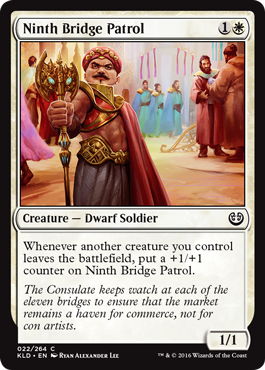
Ninth Bridge Patrol
1W
Creature — Dwarf Soldier
1/1
Whenever another creature you control leaves the battlefield, put a +1/+1 counter on Ninth Bridge Patrol.
- If Ninth Bridge Patrol and another creature you control die simultaneously (perhaps because they were both attacking or blocking), Ninth Bridge Patrol won’t be on the battlefield as its triggered ability resolves. It can’t be saved by the +1/+1 counter that would have been put on it.
- Ninth Bridge Patrol’s ability doesn’t care where the creature went or whether it’s a creature in its new zone. It may have died, been exiled, returned to your hand, and so on. It won’t trigger if an object remains on the battlefield but ceases to be a creature.
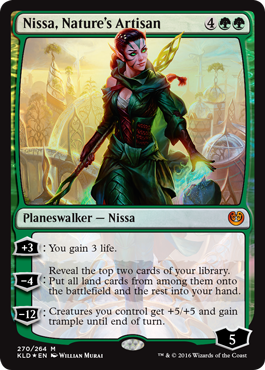
Nissa, Nature’s Artisan (Planeswalker Deck only)
4GG
Planeswalker — Nissa
5
+3: You gain 3 life.
−4: Reveal the top two cards of your library. Put all land cards from among them onto the battlefield and the rest into your hand.
−12: Creatures you control get +5/+5 and gain trample until end of turn.
- The set of creatures affected by Nissa’s last ability is determined as the ability resolves. Creatures you begin to control later in the turn and noncreature permanents that become creatures later in the turn won’t get +5/+5 or gain trample.
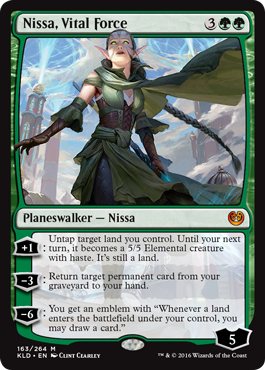
Nissa, Vital Force
3GG
Planeswalker — Nissa
5
+1: Untap target land you control. Until your next turn, it becomes a 5/5 Elemental creature with haste. It’s still a land.
−3: Return target permanent card from your graveyard to your hand.
−6: You get an emblem with “Whenever a land enters the battlefield under your control, you may draw a card.”
- You can activate Nissa’s first ability targeting a land that’s already untapped.
- After resolving Nissa’s first ability, the target land still has any abilities it had before it became a creature and any other types it had.
- A permanent card is an artifact, creature, enchantment, land, or planeswalker card.

Noxious Gearhulk
4BB
Artifact Creature — Construct
5/4
Menace
When Noxious Gearhulk enters the battlefield, you may destroy another target creature. If a creature is destroyed this way, you gain life equal to its toughness.
- Use the toughness of the creature as it last existed on the battlefield to determine how much life to gain.
- If the target creature has indestructible, it isn’t destroyed this way and you won’t gain life. If it is destroyed but put into a zone other than a graveyard, you’ll gain life.
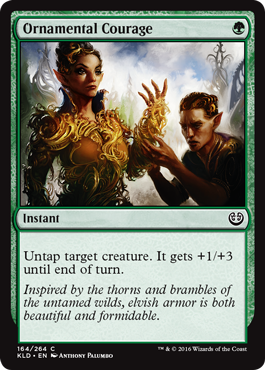
Ornamental Courage
G
Instant
Untap target creature. It gets +1/+3 until end of turn.
- You can cast Ornamental Courage targeting an untapped creature. It will still get +1/+3 until end of turn.
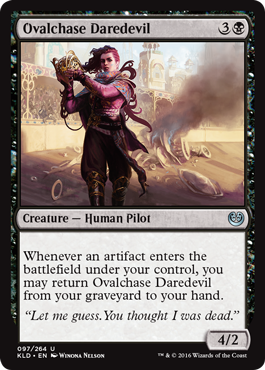
Ovalchase Daredevil
3B
Creature — Human Pilot
4/2
Whenever an artifact enters the battlefield under your control, you may return Ovalchase Daredevil from your graveyard to your hand.
- Ovalchase Daredevil’s ability triggers only if it’s already in your graveyard as an artifact enters the battlefield under your control.
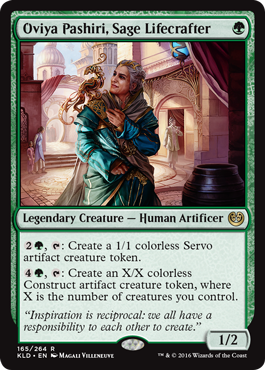
Oviya Pashiri, Sage Lifecrafter
G
Legendary Creature — Human Artificer
1/2
2G, T: Create a 1/1 colorless Servo artifact creature token.
4G, T: Create an X/X colorless Construct artifact creature token, where X is the number of creatures you control.
- The value of X is determined only as Oviya Pashiri’s last ability resolves. The token’s power and toughness won’t change as the number of creatures you control changes.
- The Construct token you’re creating doesn’t count towards X for the ability that creates it.
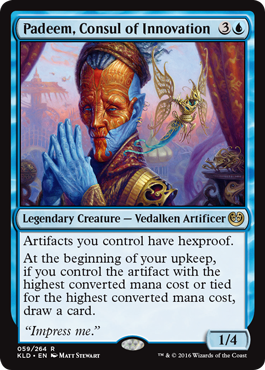
Padeem, Consul of Innovation
3U
Legendary Creature — Vedalken Artificer
1/4
Artifacts you control have hexproof.
At the beginning of your upkeep, if you control the artifact with the highest converted mana cost or tied for the highest converted mana cost, draw a card.
- The artifact you control has to have the highest converted mana cost only among artifacts on the battlefield, not among all permanents on the battlefield.
- If an artifact has X in its mana cost, X is considered to be 0.
- If you don’t control an artifact with the highest converted mana cost as your upkeep begins, Padeem’s second ability won’t trigger. You can’t cast an instant to destroy an opponent’s artifact during your turn before your upkeep begins.
- If you no longer control an artifact with the highest converted mana cost as Padeem’s triggered ability resolves, you don’t draw a card.
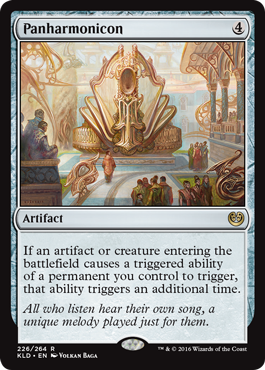
Panharmonicon
4
Artifact
If an artifact or creature entering the battlefield causes a triggered ability of a permanent you control to trigger, that ability triggers an additional time.
- Panharmonicon affects an artifact or creature’s own enters-the-battlefield triggered abilities as well as other triggered abilities that would trigger when an artifact or creature enters the battlefield. Such triggered abilities start with “when” or “whenever.”
- Abilities that create replacement effects, such as a permanent entering the battlefield with counters on it, are unaffected.
- Abilities that apply “as [this creature] enters the battlefield,” such as choosing a creature to copy with Clone, are unaffected.
- Panharmonicon’s effect doesn’t copy the triggered ability; it just causes it to trigger twice. Any choices made as you put it onto the stack, such as modes and targets, are made separately for each instance of the ability. Any choices made on resolution, such as whether to get counters or Servos for fabricate, are also made individually.
- The trigger event doesn’t have to specifically refer to “artifacts” or “creatures.” For example, Amulet of Vigor says “Whenever a permanent enters the battlefield tapped and under your control, untap it.” If a creature enters the battlefield tapped and under your control, Amulet of Vigor’s ability would trigger twice. If a land (that isn’t also an artifact or a creature) enters the battlefield tapped and under your control, Amulet of Vigor’s ability would trigger only once.
- Look at the permanent as it exists on the battlefield, taking into account continuous effects, to determine whether any triggered abilities will trigger multiple times. For example, if you control Mycosynth Lattice, which says, in part, “All permanents are artifacts in addition to their other types,” an enchantment entering the battlefield will cause triggered abilities to trigger an additional time.
- If you control two Panharmonicons, an artifact or creature entering the battlefield causes abilities to trigger three times, not four. A third Panharmonicon causes abilities to trigger four times, a fourth causes abilities to trigger five times, and so on.
- Panharmonicon affects triggered abilities of permanents you control that trigger when an artifact or creature enters the battlefield under any player’s control, not just yours.
- If Panharmonicon and an artifact or creature enter the battlefield at the same time, those permanents entering the battlefield will cause triggered abilities to trigger an additional time.
- If a triggered ability is linked to a second ability, additional instances of that triggered ability are also linked to that second ability. If the second ability refers to “the exiled card,” it refers to all cards exiled by instances of the triggered ability. For example, if Isochron Scepter’s enters-the-battlefield ability triggers twice and two instant cards are exiled, both will be copied when its second ability is activated. You may cast either or both of the copies in any order.
- In some cases involving linked abilities, an ability requires information about “the exiled card.” When this happens, the ability gets multiple answers. If these answers are being used to determine the value of a variable, the sum is used. For example, if Elite Arcanist’s enters-the-battlefield ability triggers twice, two cards are exiled. The value of X in the activation cost of Elite Arcanist’s other ability is the sum of the two cards’ converted mana costs. As the ability resolves, you create copies of both cards and can cast none, one, or both of the copies in any order.
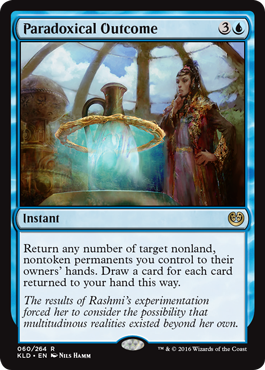
Paradoxical Outcome
3U
Instant
Return any number of target nonland, nontoken permanents you control to their owners’ hands. Draw a card for each card returned to your hand this way.
- If you control but don’t own some of the target permanents, they won’t count when determining how many cards you draw.
- If a melded permanent is returned to your hand this way, you’ll draw two cards for it.
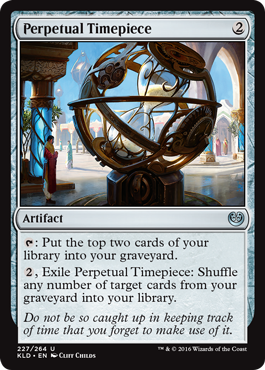
Perpetual Timepiece
2
Artifact
T: Put the top two cards of your library into your graveyard.
2, Exile Perpetual Timepiece: Shuffle any number of target cards from your graveyard into your library.
- You can activate Perpetual Timepiece’s second ability with no targets just to shuffle your library. If you choose any targets and they all become illegal targets, the ability will be countered and you won’t shuffle your library.
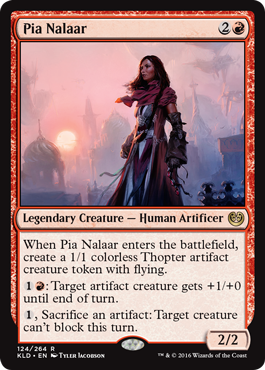
Pia Nalaar
2R
Legendary Creature — Human Artificer
2/2
When Pia Nalaar enters the battlefield, create a 1/1 colorless Thopter artifact creature token with flying.
1R: Target artifact creature gets +1/+0 until end of turn.
1, Sacrifice an artifact: Target creature can’t block this turn.
- Once a creature has blocked an attacking creature, activating Pia Nalaar’s last ability won’t cause the attacking creature to become unblocked.
- The “legend rule” cares about legendary permanents with the exact same English name. The Kaladesh card Pia Nalaar and the Magic Origins card Pia and Kiran Nalaar have different names, so you can control both at the same time.
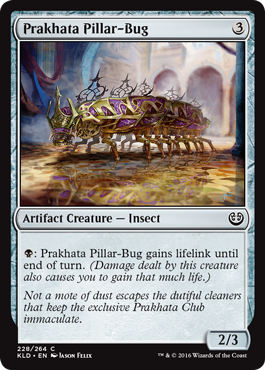
Prakhata Pillar-Bug
3
Artifact Creature — Insect
2/3
B: Prakhata Pillar-Bug gains lifelink until end of turn. (Damage dealt by this creature also causes you to gain that much life.)
- Multiple instances of lifelink are redundant.
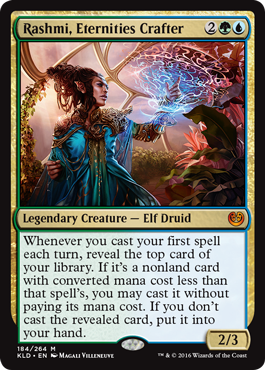
Rashmi, Eternities Crafter
2GU
Legendary Creature — Elf Druid
2/3
Whenever you cast your first spell each turn, reveal the top card of your library. If it’s a nonland card with converted mana cost less than that spell’s, you may cast it without paying its mana cost. If you don’t cast the revealed card, put it into your hand.
- If the revealed card is a land card, you put it into your hand.
- Rashmi’s ability triggers when you cast your first spell each turn, not just on your turn.
- Rashmi has to be on the battlefield at the moment you cast your first spell. If that spell is Rashmi itself, Rashmi’s ability can’t trigger. If that spell causes Rashmi to leave the battlefield as an additional cost to cast it, Rashmi’s ability can’t trigger.
- Rashmi’s ability resolves before the spell that caused it to trigger. If you cast a spell using the ability, it will also resolve before the initial spell.
- For spells with X in their mana costs, use the value chosen for X to determine the spell’s converted mana cost. For cards in your library with X in their mana costs, X is considered to be 0.
- If Rashmi’s ability resolves and the spell that caused it to trigger has been countered, use that spell’s converted mana cost as it last existed on the stack to determine whether or not you may cast the top card of your library.
- If you cast the top card of your library, you do so as part of the resolution of Rashmi’s ability. You can’t wait to cast it later in the turn. Timing permissions based on the card’s type are ignored, but other restrictions (such as “Cast [this card] only during combat”) are not.
- If you cast a card “without paying its mana cost,” you can’t pay any alternative costs, such as emerge costs. You can, however, pay additional costs. If the card has any mandatory additional costs, such as that of Cathartic Reunion, those must be paid to cast the card.
- If the card has X in its mana cost, you must choose 0 as the value of X when casting it without paying its mana cost.
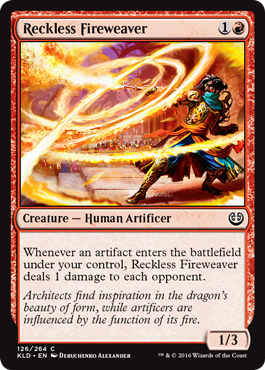
Reckless Fireweaver
1R
Creature — Human Artificer
1/3
Whenever an artifact enters the battlefield under your control, Reckless Fireweaver deals 1 damage to each opponent.
- In a Two-Headed Giant game, Reckless Fireweaver’s ability causes 2 damage total to be dealt to the opposing team.
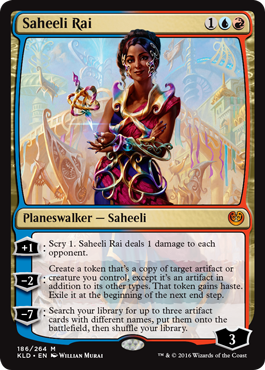
Saheeli Rai
1UR
Planeswalker — Saheeli
3
+1: Scry 1. Saheeli Rai deals 1 damage to each opponent.
−2: Create a token that’s a copy of target artifact or creature you control, except it’s an artifact in addition to its other types. That token gains haste. Exile it at the beginning of the next end step.
−7: Search your library for up to three artifact cards with different names, put them onto the battlefield, then shuffle your library.
- The token copies exactly what was printed on the original permanent and nothing else (unless that permanent is copying something else or is a token; see below). It doesn’t copy whether that permanent is tapped or untapped, whether it has any counters on it or Auras and Equipment attached to it, or any non-copy effects that have changed its power, toughness, types, color, or so on.
- The token is an artifact in addition to its other types. This is a copiable value of the token that other effects may copy. Haste and the ability’s delayed triggered ability aren’t copiable.
- If the copied permanent has X in its mana cost, X is considered to be 0.
- If the copied permanent is copying something else (for example, if the copied permanent is an Altered Ego), then the token enters the battlefield as whatever that permanent copied.
- If the copied permanent is a token, the token created with Saheeli copies the original characteristics of that token as stated by the effect that created that token.
- Any enters-the-battlefield abilities of the copied permanent will trigger when the token enters the battlefield. Any “as [this permanent] enters the battlefield” or “[this permanent] enters the battlefield with” abilities of the chosen permanent will also work.
- As Saheeli’s last ability resolves, all three artifacts enter the battlefield at the same time. Triggered abilities of any of those artifacts will see all three entering the battlefield. Replacement effects, such as that of Sculpting Steel, won’t see the others on the battlefield as they are being applied.
- In a Two-Headed Giant game, Saheeli’s first ability causes 2 damage total to be dealt to the opposing team.
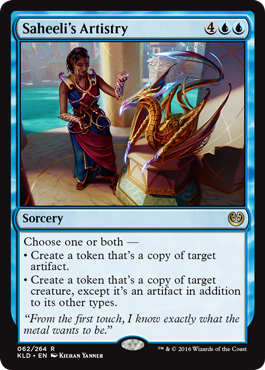
Saheeli’s Artistry
4UU
Sorcery
Choose one or both —
• Create a token that’s a copy of target artifact.
• Create a token that’s a copy of target creature, except it’s an artifact in addition to its other types.
- The token copies exactly what was printed on the original permanent and nothing else (unless that permanent is copying something else or is a token; see below). It doesn’t copy whether that permanent is tapped or untapped, whether it has any counters on it or Auras and Equipment attached to it, or any non-copy effects that have changed its power, toughness, types, color, or so on.
- If you chose the second mode, the token is an artifact in addition to its other types. This is a copiable value of the token that other effects may copy.
- If the copied permanent has X in its mana cost, X is considered to be 0.
- If the copied permanent is copying something else (for example, if the copied permanent is an Altered Ego), then the token enters the battlefield as whatever that permanent copied.
- If the copied permanent is a token, the token created with Saheeli’s Artistry copies the original characteristics of that token as stated by the effect that that created that token.
- Any enters-the-battlefield abilities of the copied permanent will trigger when the token enters the battlefield. Any “as [this permanent] enters the battlefield” or “[this permanent] enters the battlefield with” abilities of the chosen permanent will also work.
- If you choose both modes, you may target a single artifact creature twice and get two copies of that artifact creature.
- If you choose both modes, the tokens enter one at a time. Thus, if the token created by the second mode has an ability that triggers “whenever an artifact enters the battlefield,” the token created by the first mode will already be on the battlefield and won’t cause that ability to trigger.
- Any abilities that trigger during the resolution of Saheeli’s Artistry won’t be put onto the stack until Saheeli’s Artistry finishes resolving. If creating the first token causes an ability to trigger, that ability may target the second token, and vice versa.
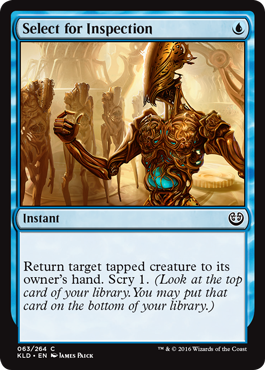
Select for Inspection
U
Instant
Return target tapped creature to its owner’s hand. Scry 1. (Look at the top card of your library. You may put that card on the bottom of your library.)
- If the target creature becomes untapped or otherwise becomes an illegal target before Select for Inspection resolves, the spell is countered. The creature remains on the battlefield and you won’t scry 1.
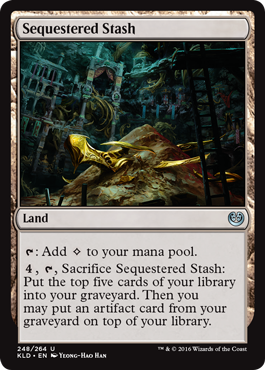
Sequestered Stash
Land
T: Add {C} to your mana pool.
4, T, Sacrifice Sequestered Stash: Put the top five cards of your library into your graveyard. Then you may put an artifact card from your graveyard on top of your library.
- Sequestered Stash’s ability doesn’t target the artifact card in your graveyard. You may choose one of the five cards you put there from your library.
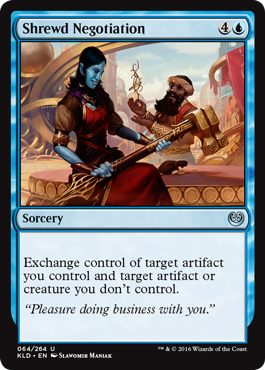
Shrewd Negotiation
4U
Sorcery
Exchange control of target artifact you control and target artifact or creature you don’t control.
- If one of the target permanents is an illegal target as Shrewd Negotiation resolves, the exchange won’t happen.
- Gaining control of an Equipment doesn’t cause it to move, though it will allow you to activate its equip ability later to attach it to a creature you control.
- In a multiplayer game, if a player leaves the game, all cards that player owns leave as well, and any effects that give the player control of permanents immediately end.
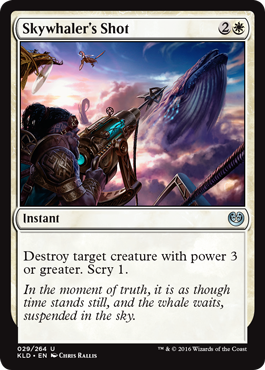
Skywhaler’s Shot
2W
Instant
Destroy target creature with power 3 or greater. Scry 1.
- If the target creature’s power becomes 2 or less before Skywhaler’s Shot resolves, the spell is countered. The creature remains on the battlefield and you won’t scry 1.
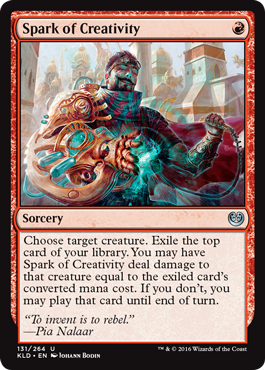
Spark of Creativity
R
Sorcery
Choose target creature. Exile the top card of your library. You may have Spark of Creativity deal damage to that creature equal to the exiled card’s converted mana cost. If you don’t, you may play that card until end of turn.
- You can’t cast Spark of Creativity without targeting a creature. If the creature becomes an illegal target for Spark of Creativity, none of its effects happen. You don’t exile the top card of your library.
- If a card in exile has X in its mana cost, X is considered to be 0.
- If a land card is exiled this way, you can play that land card until end of turn if you have any available land plays.
- You must pay all costs to play the exiled card. You may pay alternative or additional costs. If the card has any mandatory additional costs, you must pay those.
- Spark of Creativity doesn’t change when you can play the exiled card. For example, if you exile a creature card without flash, you can cast it only during your main phase when the stack is empty.
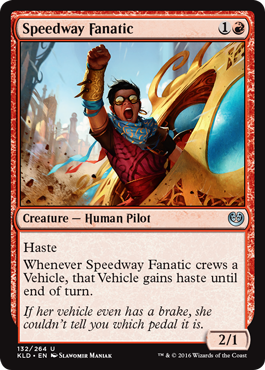
Speedway Fanatic
1R
Creature — Human Pilot
2/1
Haste
Whenever Speedway Fanatic crews a Vehicle, that Vehicle gains haste until end of turn.
- Speedway Fanatic’s triggered ability triggers when it becomes tapped to activate a crew ability. Even if Speedway Fanatic leaves the battlefield before its triggered ability resolves, that Vehicle still gains haste until end of turn.
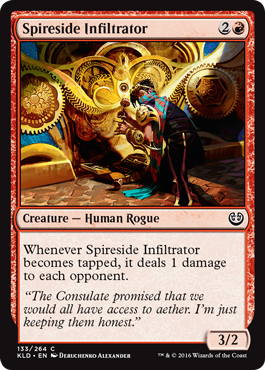
Spireside Infiltrator
2R
Creature — Human Rogue
3/2
Whenever Spireside Infiltrator becomes tapped, it deals 1 damage to each opponent.
- This is a triggered ability, not an activated ability. It doesn’t allow you to tap Spireside Infiltrator whenever you want; rather, you need some other way of tapping it, such as by attacking.
- For the ability to trigger, Spireside Infiltrator has to actually change from untapped to tapped. If an effect attempts to tap it, but it was already tapped at the time, this ability won’t trigger.
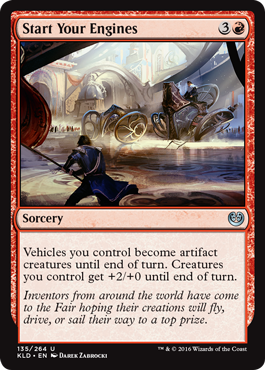
Start Your Engines
3R
Sorcery
Vehicles you control become artifact creatures until end of turn. Creatures you control get +2/+0 until end of turn.
- Vehicles you control become artifact creatures and then also get +2/+0.
- The set of Vehicles and creatures affected by Start Your Engines is determined as the spell resolves. Creatures you begin to control later in the turn won’t get +2/+0, and Vehicles you begin to control later in the turn won’t automatically become creatures and won’t get +2/+0.
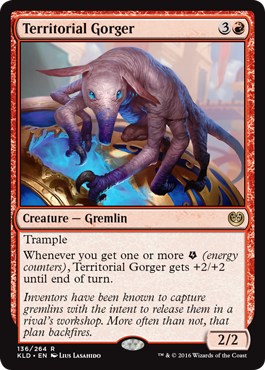
Territorial Gorger
3R
Creature — Gremlin
2/2
Trample
Whenever you get one or more E (energy counters), Territorial Gorger gets +2/+2 until end of turn.
- If you get multiple E at once, Territorial Gorger only gets +2/+2 once, not +2/+2 per E. If you get multiple E at different times, it triggers once each time.
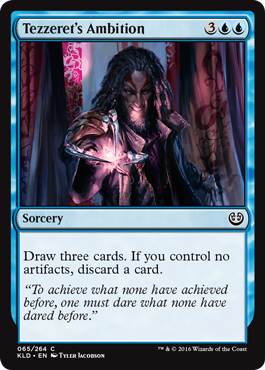
Tezzeret’s Ambition
3UU
Sorcery
Draw three cards. If you control no artifacts, discard a card.
- No player may take actions between the time you draw three cards and the time you discard. Notably, you can’t try to get an artifact onto the battlefield using the three cards you drew to avoid discarding.
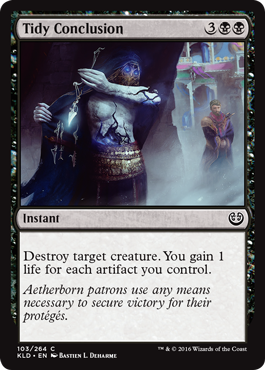
Tidy Conclusion
3BB
Instant
Destroy target creature. You gain 1 life for each artifact you control.
- If the target creature becomes an illegal target before Tidy Conclusion resolves, the spell is countered. You don’t gain any life.
- The number of artifacts you control is counted only as Tidy Conclusion resolves, after the creature is destroyed. For example, if you destroy a Fairgrounds Warden that exiled your artifact creature, the artifact creature will return and then be counted when determining how many artifacts you control.
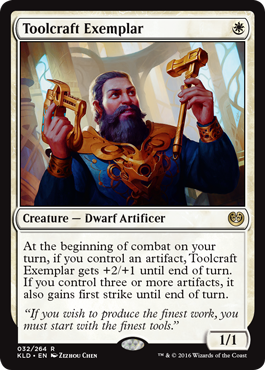
Toolcraft Exemplar
W
Creature — Dwarf Artificer
1/1
At the beginning of combat on your turn, if you control an artifact, Toolcraft Exemplar gets +2/+1 until end of turn. If you control three or more artifacts, it also gains first strike until end of turn.
- If you control no artifacts as your combat phase begins, Toolcraft Exemplar’s triggered ability doesn’t trigger at all. If you control no artifacts as the triggered ability resolves, it has no effect.
- Whether or not you control three or more artifacts is checked only as the triggered ability resolves.
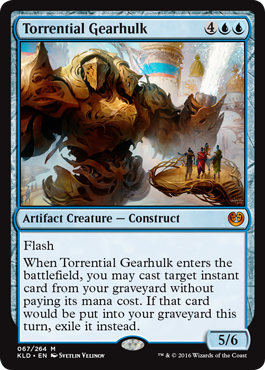
Torrential Gearhulk
4UU
Artifact Creature — Construct
5/6
Flash
When Torrential Gearhulk enters the battlefield, you may cast target instant card from your graveyard without paying its mana cost. If that card would be put into your graveyard this turn, exile it instead.
- If you cast the card, you do so as part of the resolution of Torrential Gearhulk’s triggered ability. You can’t wait to cast it later in the turn. Timing restrictions (such as “Cast [this card] only during combat”) still apply.
- If you cast a card “without paying its mana cost,” you can’t pay any alternative costs, such as emerge costs. You can, however, pay additional costs. If the card has any mandatory additional costs, such as that of Incendiary Sabotage, you must pay those to cast the card.
- If the card has X in its mana cost, you must choose 0 as the value of X when casting it without paying its mana cost.
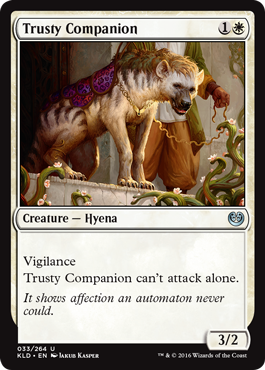
Trusty Companion
1W
Creature — Hyena
3/2
Vigilance
Trusty Companion can’t attack alone.
- Trusty Companion can be declared as an attacker only if another creature is declared as an attacker at the same time. Once it’s attacking, removing the other creature won’t cause Trusty Companion to stop attacking.
- If you control more than one creature that can’t attack alone, they can attack together, even if no other creatures attack.
- Although Trusty Companion can’t attack alone, other attacking creatures don’t have to attack the same player or planeswalker. For example, Trusty Companion could attack an opponent and another creature could attack a planeswalker that opponent controls.
- If a creature that can’t attack alone also must attack if able, its controller must attack with it and another creature if able.
- In a Two-Headed Giant game, Trusty Companion can attack along with a creature controlled by your teammate, even if no other creatures you control attack.

Underhanded Designs
1B
Enchantment
Whenever an artifact enters the battlefield under your control, you may pay 1. If you do, each opponent loses 1 life and you gain 1 life.
1B, Sacrifice Underhanded Designs: Destroy target creature. Activate this ability only if you control two or more artifacts.
- You can pay 1 only once each time Underhanded Designs’s triggered ability resolves. You can’t pay more to cause your opponents to lose more life.
- The number of artifacts you control is checked only as you activate Underhanded Designs’s last ability. It’s not checked again as it resolves.
- In a Two-Headed Giant game, Underhanded Designs’s first ability causes the opposing team to lose a total of 2 life. You still gain only 1 life.
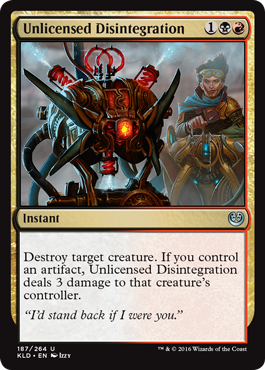
Unlicensed Disintegration
1BR
Instant
Destroy target creature. If you control an artifact, Unlicensed Disintegration deals 3 damage to that creature’s controller.
- If the target creature becomes an illegal target before Unlicensed Disintegration resolves, the spell is countered. No player is dealt damage.
- If the target creature is a legal target but isn’t destroyed by Unlicensed Disintegration, most likely because it has indestructible, Unlicensed Disintegration still deals 3 damage to the creature’s controller.
- Whether or not you control an artifact is checked only as Unlicensed Disintegration resolves, after the creature is destroyed. For example, if you destroy a Fairgrounds Warden that exiled your artifact creature, Unlicensed Disintegration deals 3 damage to Fairgrounds Warden’s controller.
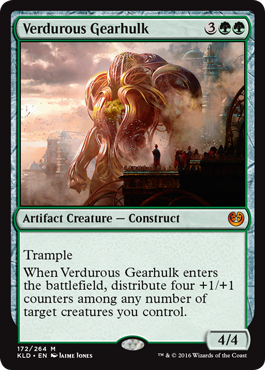
Verdurous Gearhulk
3GG
Artifact Creature — Construct
4/4
Trample
When Verdurous Gearhulk enters the battlefield, distribute four +1/+1 counters among any number of target creatures you control.
- You choose how the counters will be distributed as you put Verdurous Gearhulk’s triggered ability onto the stack. Each target creature must be assigned at least one counter.
- If one of the target creatures becomes an illegal target in response to Verdurous Gearhulk’s triggered ability, the +1/+1 counters that would have been put on that creature are lost. They can’t be put on another legal target.
- Verdurous Gearhulk can be the target of its own triggered ability.
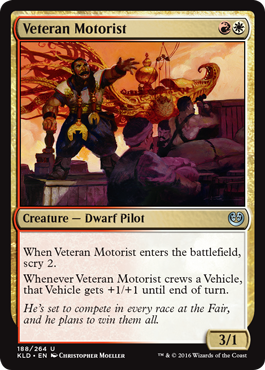
Veteran Motorist
RW
Creature — Dwarf Pilot
3/1
When Veteran Motorist enters the battlefield, scry 2.
Whenever Veteran Motorist crews a Vehicle, that Vehicle gets +1/+1 until end of turn.
- Veteran Motorist’s last ability triggers when it becomes tapped to activate a crew ability. Even if Veteran Motorist leaves the battlefield before its triggered ability resolves, that Vehicle still gets +1/+1 until end of turn.
- Veteran Motorist’s last ability resolves before the crew ability that it was tapped to activate. The +1/+1 bonus will be in effect as the Vehicle becomes an artifact creature.

Weldfast Monitor
3
Artifact Creature — Lizard
3/2
R: Weldfast Monitor gains menace until end of turn.
- Once a creature has blocked Weldfast Monitor, gaining menace won’t cause Weldfast Monitor to become unblocked.
- Multiple instances of menace are redundant.
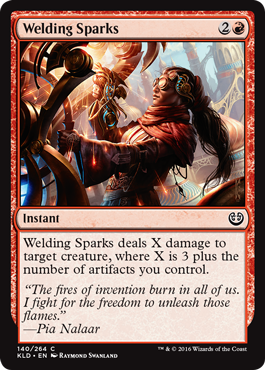
Welding Sparks
2R
Instant
Welding Sparks deals X damage to target creature, where X is 3 plus the number of artifacts you control.
- If you control zero artifacts, Welding Sparks deals 3 damage to the target creature.
- The number of artifacts you control is counted only as Welding Sparks resolves.
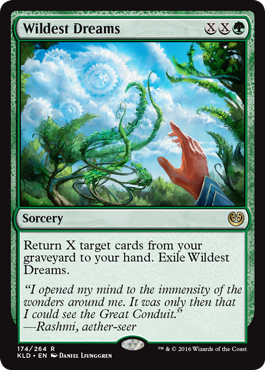
Wildest Dreams
XXG
Sorcery
Return X target cards from your graveyard to your hand. Exile Wildest Dreams.
- If each target card is an illegal target as Wildest Dreams resolves, Wildest Dreams is countered and is put into its owner’s graveyard. It’s not exiled.
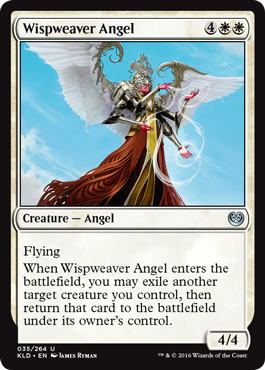
Wispweaver Angel
4WW
Creature — Angel
4/4
Flying
When Wispweaver Angel enters the battlefield, you may exile another target creature you control, then return that card to the battlefield under its owner’s control.
- Auras attached to the exiled creature will be put into their owners’ graveyards. Equipment attached to the exiled creature will become unattached and remain on the battlefield. Any counters on the exiled creature will cease to exist.
- If a creature token is exiled this way, it will cease to exist and won’t return to the battlefield.
- Wispweaver Angel’s triggered ability can target another Wispweaver Angel. If so, the two Angels can loop in and out of exile as many times as you’d like before you choose to target another creature or not to use the triggered ability.
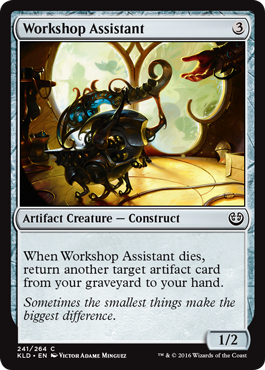
Workshop Assistant
3
Artifact Creature — Construct
1/2
When Workshop Assistant dies, return another target artifact card from your graveyard to your hand.
- If another artifact card is put into your graveyard at the same time as Workshop Assistant, you can target it with Workshop Assistant’s triggered ability.
Magic: The Gathering, Magic, Kaladesh, Battle for Zendikar, Oath of the Gatewatch, Shadows over Innistrad, Eldritch Moon, Aether Revolt, and Magic Origins are trademarks of Wizards of the Coast LLC in the USA and other countries. ©2016 Wizards.
